Voting is the most important expression of civic engagement in America. There are over 500,000 elected officials across the United States, from President to the local dogcatcher (Duxbury, Vermont elects their dog catcher every year). The contours of a political campaign are familiar to all: speeches, debates, rallies and party conventions, culminating when Americans gather to cast their ballots in November. With the votes tallied, winners prepare to take office and unsuccessful candidates return to private life. But what do these campaigns leave behind after Election Day?
Trail to the Voting Booth: An Exploration of Political Ephemera shows the variety of ways Americans talk about politics and the way these discussions manifest in physical objects. From Farmer Refuted, Alexander Hamilton’s 1775 pamphlet on the political relationship between Great Britain and the American colonies, to campaign websites from the 2018 election cycle, Americans enjoy discussing politics, sharing their opinions about candidates and public issues, and tracking the election process every two years. This political dialog has taken many physical forms over the last 240+ years, including pamphlets, song sheets, cartoons, buttons, campaign signs, bumper stickers, costume jewelry, housewares, clothing, toys and more. In the moment, they allow people to proudly display their support for causes and candidates, and later serve as a memory of elections past.
This Special Collections exhibition, curated by John Caldwell, Coordinator of Political Papers and Electronic Records, launched online in September 2020 and will be on view during spring semester 2021 in the Special Collections Gallery of Morris Library.
Banner image credit: Dustin Frohlich, Special Collections, University of Delaware Library, Museums and Press.
Case 1: Apportionment
The trail to the voting booth begins before any candidate announces their intention to seek office with the apportionment of voters, and the establishment of election districts.
The U.S. Constitution requires the federal government to count all its citizens every ten years, in part to establish the number of House of Representative members each state is allotted. Between the Census (conducted in years ending in “0”) and the subsequent Congressional election (held in years ending in “2”), states are allotted the appropriate number of representatives.
With Census data in hand, state-level redistricting begins. State legislatures or independent commissions create maps for congressional districts based on population and geographic boundaries. A similar process is used to establish state legislative districts for the General Assembly. Delaware is one of 34 states where the state legislature sets the district maps for federal and state elections.
Debates around reapportionment have resulted in numerous proposed solutions, including Constitutional amendments establishing rules for apportionment, and non-partisan redistricting methods.
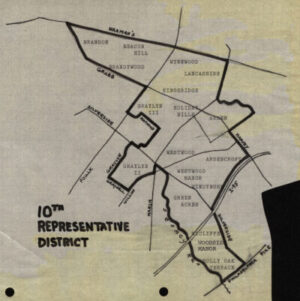
10th state legislative district map, 1974
Creator unknown
10th state legislative district map, 1974
Gwynne P. Smith papers
Map showing the geographic bounds of the 10th legislative district for the Delaware House of Representatives. This is the district Gwynne Smith represented in the General Assembly.
More about this item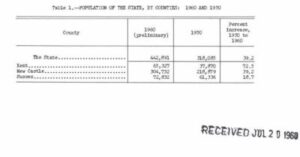
1960 Census of Population Preliminary Reports, Population Counts for States, Delaware, July 1960
U.S. Department of Commerce, Bureau of Census
1960 Census of Population Preliminary Reports, Population Counts for States, Delaware, July 1960
Senator J. Allen Frear, Jr., paper
Preliminary population data for the state of Delaware.
More about this item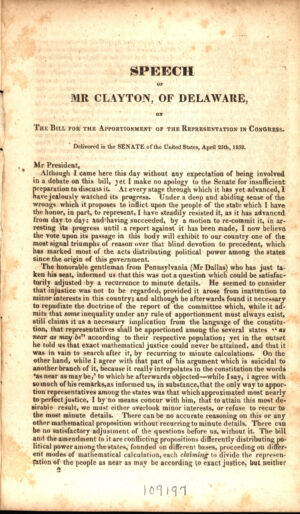
Speech of Mr Clayton, of Delaware, on the Bill for the Apportionment of the Representation in Congress: Delivered in the Senate of the United States, April 25th, 1832
John M. Clayton
Speech of Mr Clayton, of Delaware, on the Bill for the Apportionment of the Representation in Congress: Delivered in the Senate of the United States, April 25th, 1832. Printed at the Office of Jonathan Elliot, Penn. Avenue, [Washington, D.C.], 1832.
![[State] Senate Redistricting Plan with map of proposed districts for New Castle County, DE, July 16, 1991](https://exhibitions.lib.udel.edu/trail-to-the-voting-booth/wp-content/uploads/sites/97/2020/09/0689_2_88_GOP_reapportionment_19911-scaled-e1599580426998.jpg )
[State] Senate Redistricting Plan with map of proposed districts for New Castle County, DE, July 16, 1991
Delaware Senate Republican Caucus
[State] Senate Redistricting Plan with map of proposed districts for New Castle County, DE, July 16, 1991
Myrna Bair papers
During redistricting debates, political parties work to maximize their share of possible seats. This fact sheet outlines how the Republican plan complies with federal and state requirements for population distribution, as well as the proposed map for New Castle County, dubbed the “Darth Vader” map.
More about this item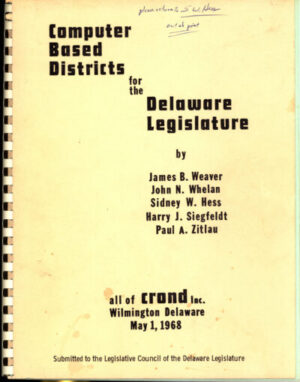
Computer Based Districts for the Delaware Legislature, May 1, 1968
James B. Weaver, John N. Whelan, Sidney W. Hess, Harry J. Siegfeldt, and Paul A. Zitlau.
Computer Based Districts for the Delaware Legislature, May 1, 1968.
Sidney W. Hess Computer Research on Nonpartisan Districting, Inc. records
Because of the partisan nature of reapportionment, numerous plans have been proposed to take politics out of redistricting. This plan from 1968 outlines a computer-based model for creating legislative districts for the Delaware General Assembly.
More about this itemCase 2: Campaign Strategy
A well-organized campaign is important for electoral success. Running is easy, developing a plan to win is harder.
![PPP Report [of campaign activities], September 30, 1972](https://exhibitions.lib.udel.edu/trail-to-the-voting-booth/wp-content/uploads/sites/97/2020/09/0745_9_199_campaign_org1-scaled-e1599591775170.jpg )
PPP Report [of campaign activities], September 30, 1972
People for Peterson
PPP Report [of campaign activities], September 30, 1972
Russel W. Peterson papers
This memo highlights the work of Governor Peterson’s reelection campaign on numerous fronts, including polling, interactions with interest groups, and setting up campaign offices.
More about this item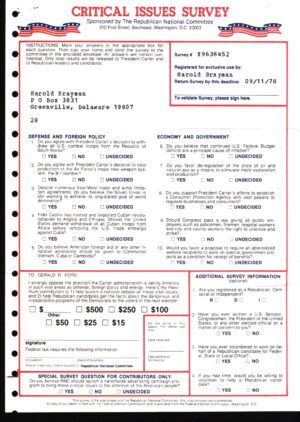
Critical Issues Survey, 1980
Republican National Committee
Critical Issues Survey, 1980
Harold Brayman papers
Campaigns are never static. Adjustments to the governing message are necessary in the midst of the campaign as new issues enter public discourse. Issue polling and voter surveys keep candidates informed on how the electorate views their messaging, and track the issues that voters consider important in a given election.
More about this item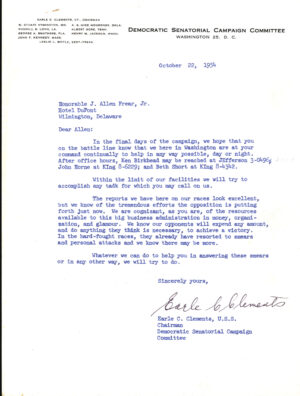
Letter to Senator J. Allen Frear, Jr., offering assistance for final days of 1954 campaign, October 22, 1954
Earle C. Clements, Chairman, Democratic Senatorial Campaign Committee
Letter to Senator J. Allen Frear, Jr., offering assistance for final days of 1954 campaign, October 22, 1954
Senator J. Allen Frear, Jr., papers
Party affiliated campaign committees in Congress offer support and encouragement to candidates as part of each party’s effort to maximize their control of the legislative branch.
More about this item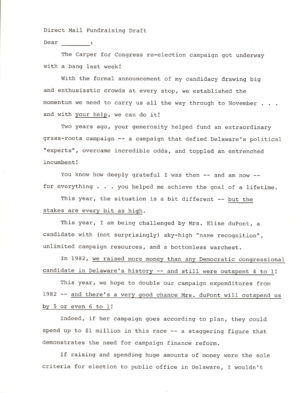
Draft Direct Mail Fundraising Letter, 1982
Carper for Congress
Draft Direct Mail Fundraising Letter, 1982
Thomas R. Carper congressional papers
Facsimile
Elections are not cheap. Raising enough money to run an effective campaign is of utmost importance. Campaigns will frequently ask for donations directly from potential voters, especially small-dollar donations.
More about this item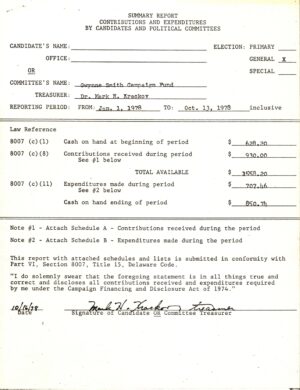
Campaign finance filing form, October 1978
Gwynne Smith Campaign Fund
Campaign finance filing form, October 1978
Gwynne P. Smith papers
Campaigns, at all levels of public office, are required to regularly disclose fundraising and campaign spending to ensure that elections are running fairly.
More about this item
Late Starter, October 11, 1991
Jack Jurden
“Late Starter,” Wilmington News Journal, October 11, 1991
Jack Jurden political and editorial cartoons collection
Facsimile
Political cartoons blend caricature, satire, and contemporary politics to distill complex policy debates or critical social issues into a single image. As a political tool, cartoons were very effective in communicating ideas in a brief and simple manner; like campaign songs, political cartoons could convey a simple political message without relying on extensive education or a deep knowledge of politics.
More about this itemCase 3: Campaign Surrogates
Candidates cannot be everywhere at once. In order to connect to as many voters as possible, candidates employ surrogates to take their message to the people. Many are regular people volunteering their time to forward a candidate’s message, helping at events, raising money, canvassing neighborhoods, and helping to get out the vote on Election Day. Sometimes, surrogates are elected officials campaigning directly for a candidate (or against their opponent).
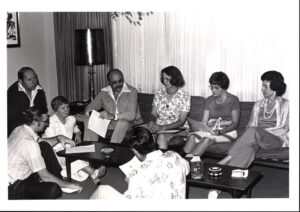
Gwynne Smith meeting with campaign volunteers in her home, August 1976
Walter Westerberg, Jr.
Gwynne Smith meeting with campaign volunteers in her home, August 1976
Photograph
Gwynne P. Smith papers
![I Am A [Adlai] Stevenson [precinct] Captain](https://exhibitions.lib.udel.edu/trail-to-the-voting-booth/wp-content/uploads/sites/97/2020/09/stevenson_captain-e1599594885253.jpg )
I Am A [Adlai] Stevenson [precinct] Captain" button, circa 1950s
Creator unknown
“I Am A [Adlai] Stevenson [precinct] Captain” button, circa 1950s
Jerome O. Herlihy political campaign ephemera collection
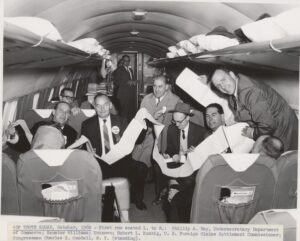
GOP truth quad, October 1960
Mack Studio
GOP Truth Squad, October 1960
Photograph
Senator John J. Williams papers
In 1960, Senator John J. Williams (R-Del.) was a member of the “Truth Squad,” a group of Republican politicians traveling behind Democratic presidential nominee John F. Kennedy and his surrogates to contest the Democratic campaign message and advocate for Republican candidate and sitting Vice President, Richard Nixon.
More about this item
"GOP Women's Nixon-Agnew Voteswagon Tour - 1968," excerpt from The Chairman's Report, 1968
Republican National Committee
“GOP Women’s Nixon-Agnew Voteswagon Tour – 1968,” excerpt from The Chairman’s Report, 1968
Marj Skinker album of Republican women’s Voteswagon tour
This excerpt shows the Voteswagon route from Washington, D.C. to Anaheim, CA.
More about this item
Photographs on the 1968 Nixon-Agnew Voteswagon bus, 1968
Marj Skinker
Photographs on the 1968 Nixon-Agnew Voteswagon bus, 1968
Marj Skinker album of Republican women’s Voteswagon tour
The “Voteswagon” was a women-led effort in 1968 to secure votes for the Republican ticket of Richard Nixon and Spiro Agnew. Over the 27 day road trip, the women involved traveled over 7,000 miles and visited 74 cities, distributing campaign literature, and linking campaign events for local office with the national Republican campaign.
More about this item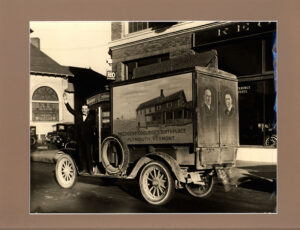
E.A. Seidel and his wagon as part of the Coolidge-Dawes Lincoln Tour
Creator unknown
Photograph of E. A. Seidel and his wagon as part of the Coolidge-Dawes Lincoln Tour, 1924
Photograph
Surrogates can also be enthusiastic volunteers who go above and beyond to participate in larger-scale campaigning. One example includes the Coolidge-Dawes Lincoln Tour, a 1924 parade of over 100,000 vehicles along the Lincoln Highway between New York and San Francisco in support of Republican candidate and incumbent President Calvin Coolidge. The image below shows E. A. Seidel, who drove the lead truck for the 56 day event.
More about this itemCase 4: Campaign Events
To build rapport with voters and get their governing message out, candidates have two avenues of political communication: direct and indirect communication. In-person events and interpersonal contact between candidates, their surrogates and voters are considered direct communication. Indirect communications encompasses all other modes and mediums where the candidate and voter can “interact.”
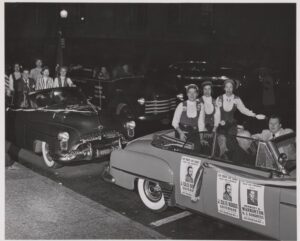
Unidentified individuals at a campaign rally, 1952
Lubitsh & Bungarz Promotional Photography
Unidentified individuals at a campaign event,”1952
Photograph
Senator John J. Williams papers
Rallies such as this are large-scale events allow candidates to address many voters at the same time. Rallies are opportunities for candidates to speak, and for supporters to gather together.
More about this item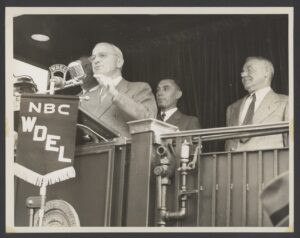
Campaigns: Presidential candidate Harry S. Truman, Senator Frear, and Vice Presidential candidate Alben William Barkley, making a campaign speech in Wilmington, DE, October 1948
Creator unknown
Campaigns: Presidential candidate Harry S. Truman, Senator Frear, and Vice Presidential candidate Alben William Barkley, making a campaign speech in Wilmington, DE, October 1948
Photograph
Senator J. Allen Frear, Jr., papers
![Governor [Alfred E.] Smith's Special Campaign Train' itinerary and train menu, September-October 1928](https://exhibitions.lib.udel.edu/trail-to-the-voting-booth/wp-content/uploads/sites/97/2020/09/1_12_SMith_train_19283-scaled-e1599181375773.jpg )
Governor [Alfred E.] Smith's Special Campaign Train' itinerary and train menu, September-October 1928
Presidential campaign of Al Smith
Governor [Alfred E.] Smith’s Special Campaign Train’ itinerary and train menu, September-October 1928
Harold Brayman papers
For presidential candidates, a series of rallies needs to be planned. While modern candidates can fly around the country, in previous campaigns, train travel was essential to get between campaign stops. The time needed to travel between stations led to candidates delivering stump speeches from the back of the train. These “whistle stop tours” were very common in the late nineteenth and early twentieth centuries.
More about this item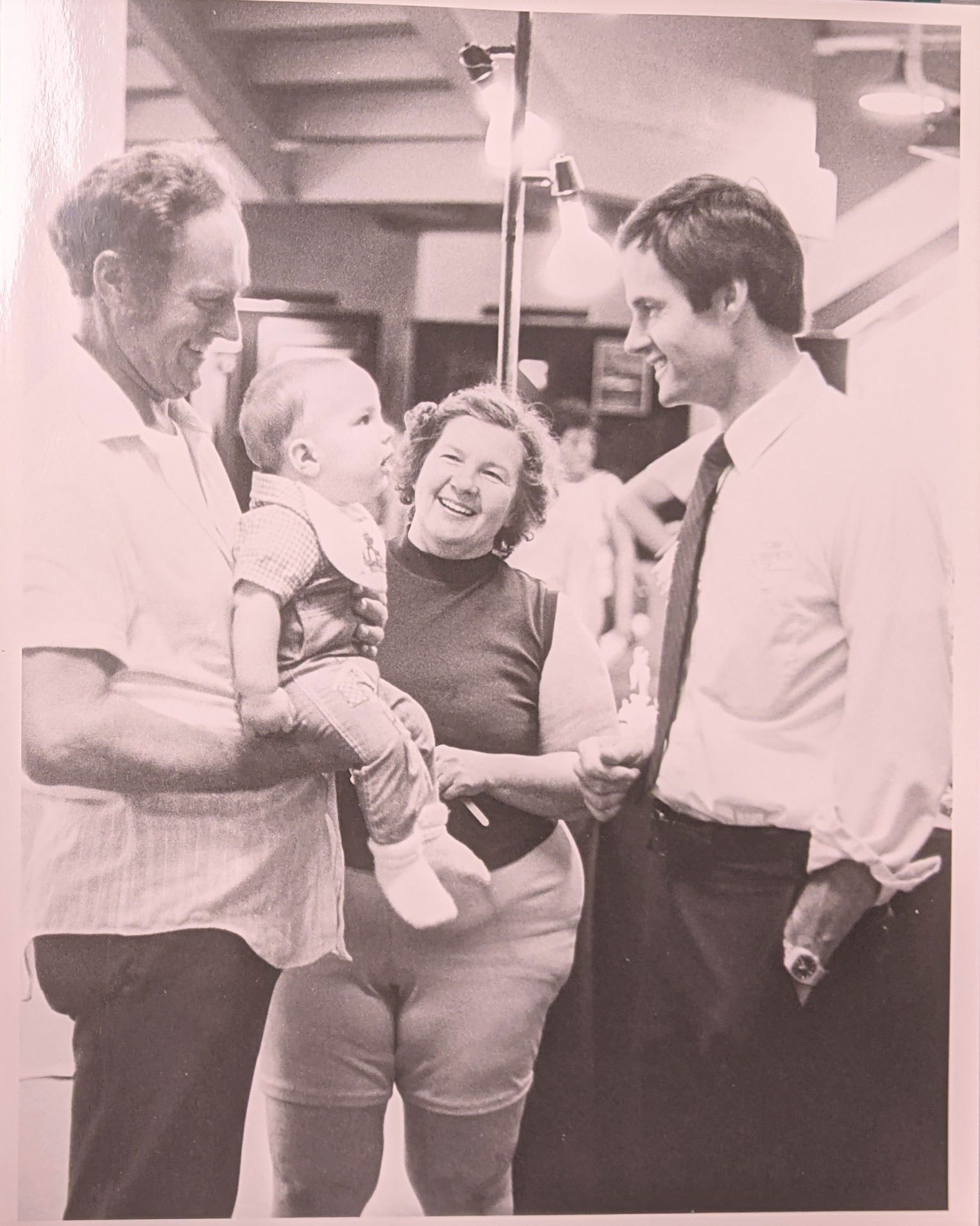
Tom Carper meeting constituents, No date
Creator unknown
Tom Carper meeting constituents, No date
Photograph
Thomas R. Carper congressional papers
More casual meet-and-greet events are very common, especially in a small state like Delaware. Whether at the State Fair, a high-end reception, or walking through neighborhoods, any opportunity for a candidate to interact with supporters is important.
More about this item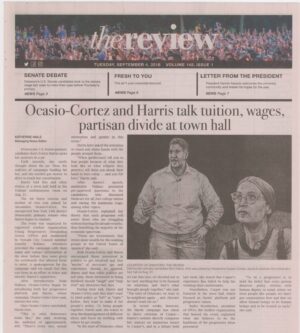
Katherine Nails, "Ocasio-Cortez and Harris talk tuition, wages, partisan divide at town hall" UD Review, September 4, 2018
Katherine Nails
“Ocasio-Cortez and Harris talk tuition, wages, partisan divide at town hall,” UD Review, September 4, 2018
University of Delaware ephemera collection related to politics, policy and government
Town Halls are open forums designed to allow voters to engage in dialog with political candidates about important issues. Town halls are important during the campaign, but are useful to maintain engagement with constituents between election cycles.
More about this itemCase 5: Speech and Debate
Candidates give speeches as a routine part of their campaigning. It is one of the most effective ways to communicate with voters en masse. The stump speech is one of the oldest methods of direct campaigning in U.S. politics. In the early days of the Republic, political candidates would address potential voters standing on a literal stump in the center of town. Today, stump speeches refer to standard, oft-repeated speeches that candidates repeat at many of their campaign stops.
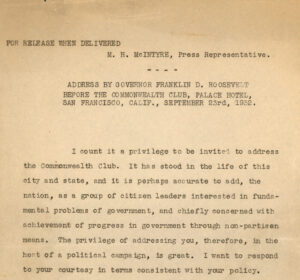
Address by Governor Franklin D. Roosevelt before the Commonwealth Club, Palace Hotel, San Francisco, CA, September 23, 1932
Franklin D. Roosevelt
Address by Governor Franklin D. Roosevelt before the Commonwealth Club, Palace Hotel, San Francisco, CA, September 23, 1932
Harold Brayman papers
Stump speeches are designed to be repetitive, easy for the candidates to remember, and introduce the candidate to the people. They are used to make promises and test policy stances in front of the electorate. As a rule, they are not dramatic or noteworthy, but serve a valuable role in defining and differentiating candidates and their governing philosophies.
More about this item
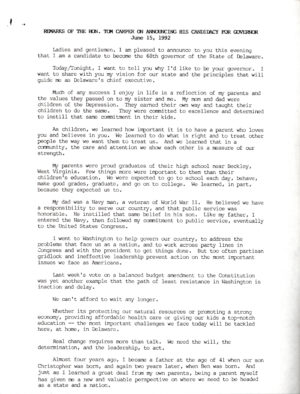
Remarks of the Hon. Tom Carper on Announcing his Candidacy for Governor, June 15, 1992
Thomas R. Carper
Remarks of the Hon. Tom Carper on Announcing his Candidacy for Governor, June 15, 1992
Thomas R. Carper congressional papers
Facsimile
When candidates announce their intent to run for office, they use their speech to explain their rationale for seeking office and gives voters a first look at their governing priorities.
More about this item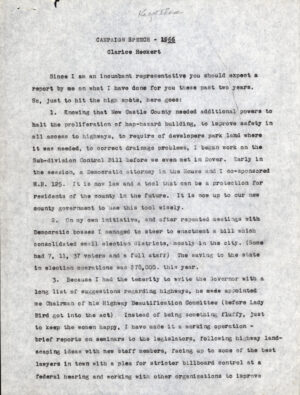
Campaign speech, 1966
Clarice Heckert
Campaign speech, 1966
Clarice U. Heckert papers
Facsimile
When seeking reelection, incumbents will highlight their accomplishments as a major component of their stump speeches.
More about this itemDebates offer candidates a structured forum to discuss issues of importance to the electorate. In the nineteenth century, debates were important for highlighting differences between candidates. One unusual thing about debates in this period is that, instead of candidates facing off against each other; instead, surrogates would participate in the debate. Most nineteenth century debates garnered little attention beyond the local constituency.
The first televised debate between presidential candidates was in 1960, when Senator John F. Kennedy debated Vice President Richard Nixon. This meeting between Kennedy and Nixon set the precedent for the modern political debate, and encouraged the practice for lower offices across the country.
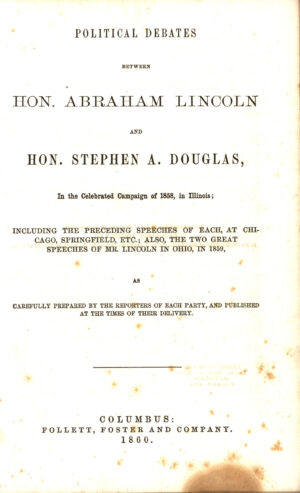
Political Debates between Hon. Abraham Lincoln and Hon. Stephen a. Douglas, in the Celebrated Campaign of 1858, in Illinois : Including the Preceding Speeches of Each, at Chicago, Springfield, Etc. : Also, the Two Great Speeches of Mr. Lincoln in Ohio, in 1859, As Carefully Prepared by the Reporters of Each Party, and Published at the Times of Their Delivery
Lincoln, Abraham, et al. Political Debates between Hon. Abraham Lincoln and Hon. Stephen a. Douglas, in the Celebrated Campaign of 1858, in Illinois : Including the Preceding Speeches of Each, at Chicago, Springfield, Etc. : Also, the Two Great Speeches of Mr. Lincoln in Ohio, in 1859, As Carefully Prepared by the Reporters of Each Party, and Published at the Times of Their Delivery. [5th edition] ed., Follett, Foster and Company, 1860.
One of the most well-known examples of political debate in American history was the famous Lincoln-Douglas debates in 1858. Abraham Lincoln was challenging Stephen Douglas, the incumbent, in the Illinois U.S. Senate race. Lincoln challenged Douglas to a series of seven debates on the issue of slavery. These served as the first significant political campaign debate in U.S. history, drawing national attention and setting up a preview of the 1860 presidential election, where the two men would challenge each other again.
More about this item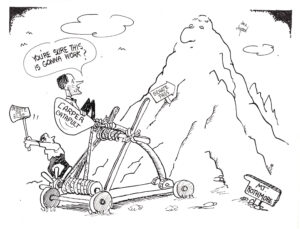
Carper/Roth Debate cartoon, 2000
Jack Jurden
Carper/Roth Debate cartoon, Wilmington News Journal, 2000
Jack Jurden political and editorial cartoons collection
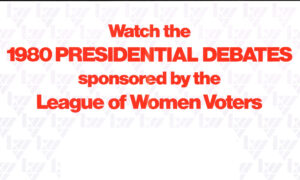
Banner, "Watch the 1980 Presidential Debates sponsored by the League of Women Voters," 1980
League of Women Voters
Banner, “Watch the 1980 Presidential Debates sponsored by the League of Women Voters,” 1980
Archive of the League of Women Voters of Greater Newark, Delaware
Presidential debates have been coordinated and hosted by the Commission on Presidential Debates since the 1988 campaign cycle. Before then, interest groups, including the League of Women Voters, served as the hosts for presidential candidates to debate one another.
More about this item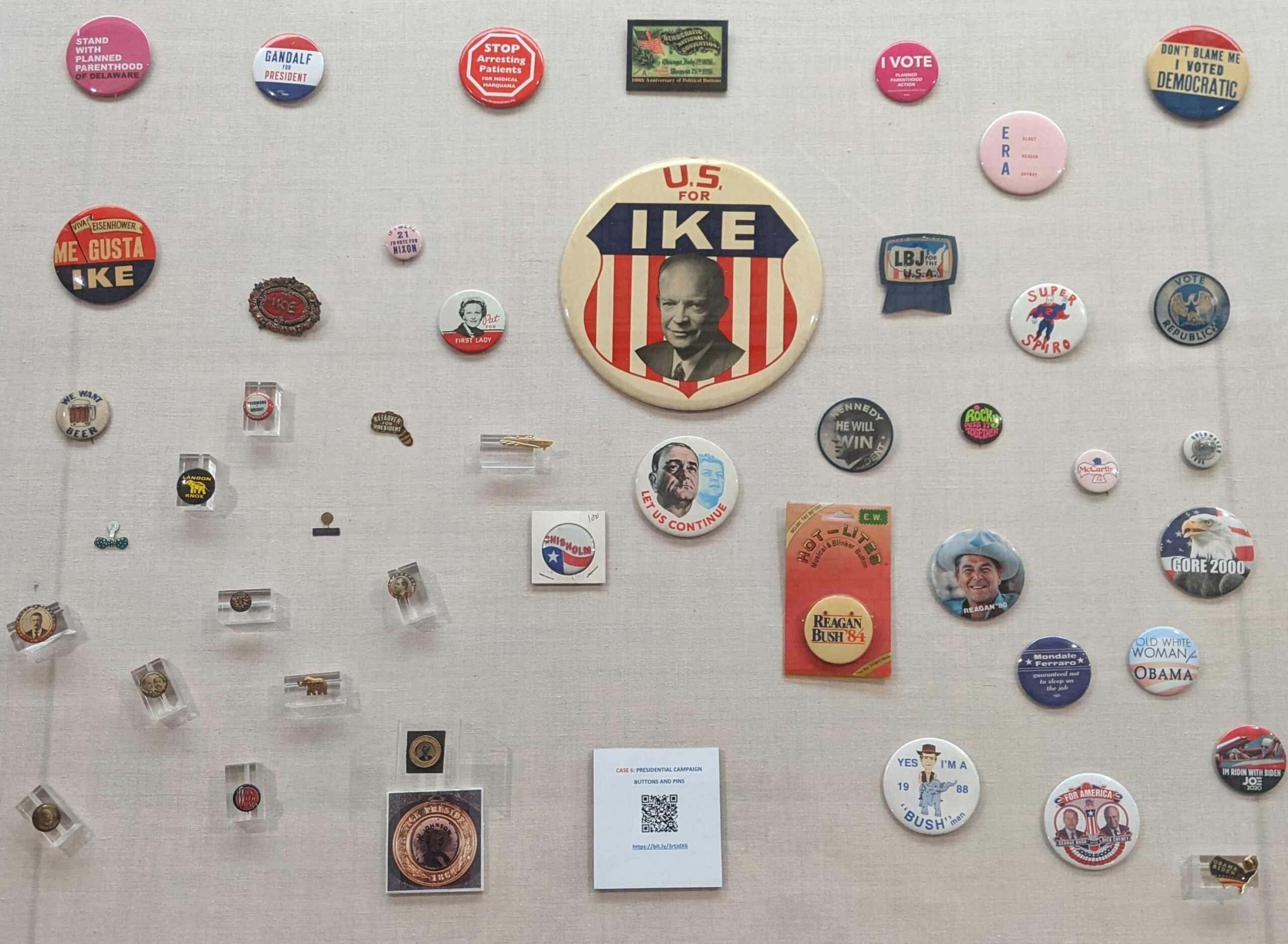
Presidential campaign buttons and pins
Case 6: Presidential campaign buttons and pins
Campaign buttons are one of the most iconic pieces of campaign ephemera. Buttons date back to George Washington’s first inauguration in 1789. These were actual clothing buttons and fasteners, where function was as important as displaying support for a candidate.
The next development in what we would consider a campaign button came in the mid-nineteenth century with advances in photography. Ferrotypes, also known as tintypes, were small photographs developed on thin sheets of coated iron or tin, becoming popular in the U.S. during the 1850s.
The first “modern” campaign button appeared during the 1896 presidential election between William McKinley and William Jennings Bryan. These buttons were made of celluloid, the world’s first synthetic plastic-like material. A thin sheet of celluloid protected an image printed on paper and wrapped around a metal disk with a pin on the back. In the 1920s, a cheaper production method replaced the “golden age” cellulose buttons, with images were printed directly on thin pieces of metal that would be punched out and shaped into a button.
Other button styles have also developed over time, including tabs, flashers (buttons containing two images that change depending on the angle at which you see the button), lapel pins/studs and electronic buttons.
Buttons are not limited to political candidates, but also for political parties and specific policy issues. Novelty, satirical, and homemade buttons of a political nature are also common.
More about this item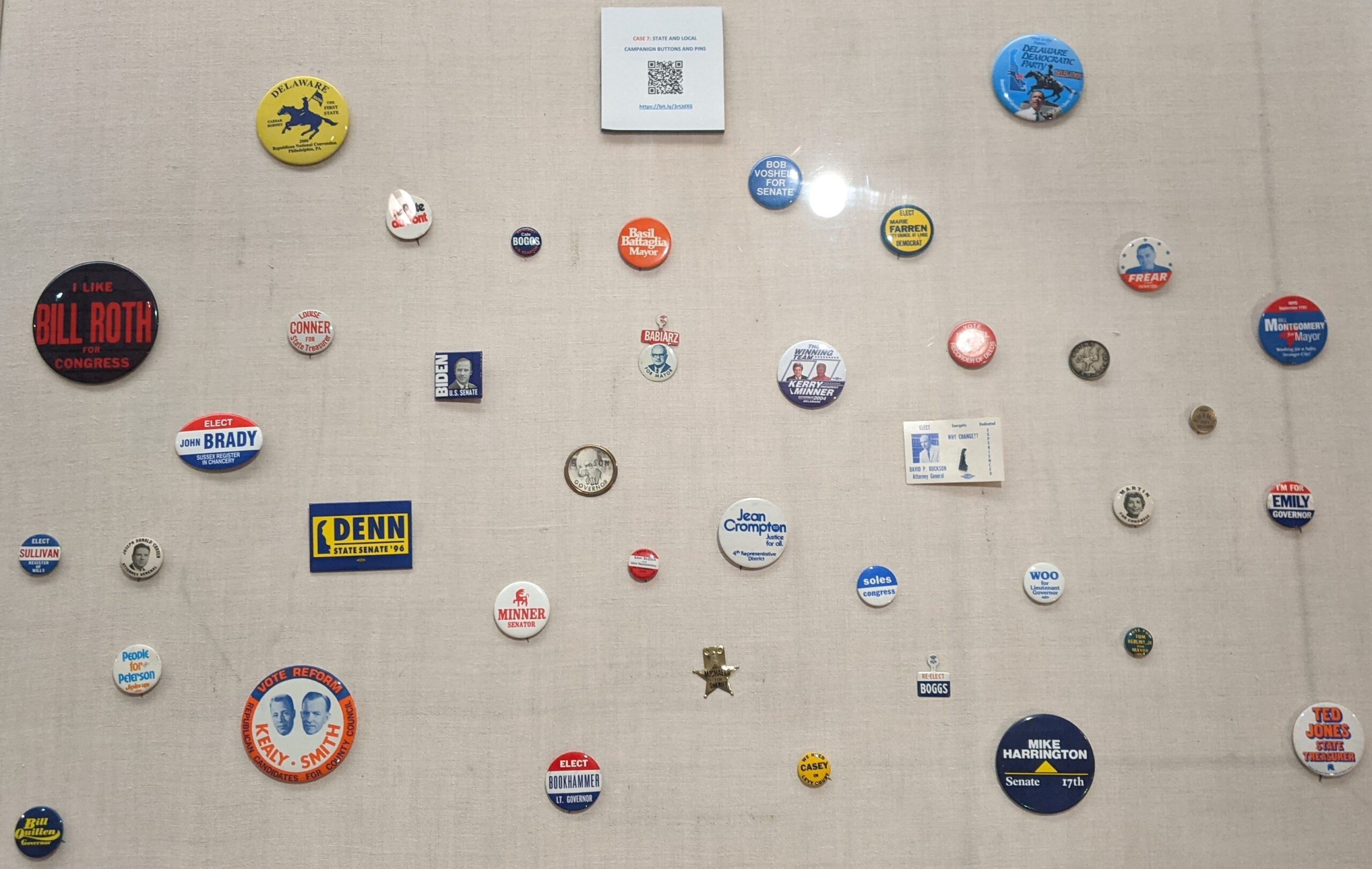
State and local office campaign buttons and pins
Case 7: State and local office campaign buttons and pins
Over the course of the twentieth century, campaign buttons were created for local and state level candidates as well.
More about this item
Campaign brochures and direct mail
Case 8.1: Campaign brochures and direct mail
Campaign brochures are a common handout for candidates, especially in local elections. Containing photographs of the candidate, a brief biography, and a series of campaign promises, brochures are handed out by canvassers in the neighborhood, by campaign workers are larger in-person events, or mailed out to voters.
Direct mail campaigns, even in the digital era, are still important tools to connect with voters. Direct mail campaigning allows candidates to make direct contact with voters, ask for support, or share a targeted message with specific demographics.
1. Mary Jornlin for State Treasurer
Mary Jornlin for State Treasurer mailer resembling a check, 1972
Robert J. Voshell collection of Delaware political ephemera scrapbooks
2. Tom du Pont
Tom du Pont, Candidate for State Rep., 14th district Republican first aid card, [1970]
Robert J. Voshell collection of Delaware political ephemera scrapbooks
3. Delaware State Republican Party
“Let’s make it another Republican Year, Introducing the Kent County Slate of Candidates” brochure, 1972
Robert J. Voshell collection of Delaware political ephemera scrapbooks
4. City People for Mayor Maloney
“Maloney, a new hope for city people” brochure, 1972
Robert J. Voshell collection of Delaware political ephemera scrapbooks
5. Creator unknown
“Please Re-elect Colin Bioini – Your State Senator” postcard, No date
Robert J. Voshell collection of Delaware political ephemera scrapbooks
6. Faith and Freedom Coalition
Voter Guide for Delaware, 2012
University of Delaware ephemera collection related to politics, policy and government
Candidates are not the only ones to campaign through the mail. Interest groups also use direct mail campaigns to compare candidates and make endorsements.
7. Delaware Democratic Party
Attack Ad against President George Bush’s reelection, 2004
University of Delaware ephemera collection related to politics, policy and government
Candidates can use direct mailings to drop opposition research or make arguments against their opponents. Attack ad mail is most commonly sent out in the last days of the campaign.
More about this item
Campaign songs
Case 8.2: Campaign songs
In the early days of the republic, voters had to be white, male and landowners, limiting the electorate to the wealthy and well educated. By the end of the 1830s, most states had repealed the landowner requirement, expanding the voter pool to less educated men. Campaign songs became tools to educate these new voters on candidates and issues. By composing simple songs set to well-known tunes, campaign songs could travel the country on the lips of voters and widen the reputation of the candidate.
Campaign songs remained popular throughout the nineteenth and early twentieth centuries, when the expanding media landscape allowed campaigns to select popular music of the day to incorporate into their campaigns, a tradition that continues to this day.
1. George W. Clark
“Salt River Chorus.” Printed in The Free Soil Minstrel, New York: Martyn & Ely, 1848
The phrase “Salt River” originated in the American South during the Antebellum period, and refers to a river in Kentucky. In a political context, “Salt River” is used as a euphemism for political defeat, specifically losing an election.
2. Gray & Clarkson Printers
“Raise the Nation’s Emblem, Boys!” Printed in The Protection Collection of Campaign Songs for 1888.
Gray & Clarkson Printers, 1888.
3. W.F. Shaw Co.
The Tippecanoe Campaign Songster: Harrison and Morton; Sketch of Their Lives and Full Text of the Republican Platform.
W.F. Shaw, 1888.
4. Anita (Anita Lily) Pollitzer (1894-1975) Josephine Preston Peabody (1874-1922)
“The Woman’s Party Song.” Written for piano by Anita Pollitzer ; words by Josephine Preston Peabody. National Woman’s Party, undated.
Woman Suffrage Collection
Though primarily associated with presidential campaigns, campaign songs were also used to rally support for social and policy issues, including abolition and temperance.
5. Creator unknown
Sing for Willkie! Campaign songs for Wendell Willkie, 1940
Harold Brayman papers

Political pamphlets
Case 8.3: Pamphlets
Pamphlets are brief, unbound publications. With the explosion of the printing in the early sixteenth century, pamphlets became a dominant form of printed communication in Europe. In England, and later in the American colonies, pamphlets were printed on every topic, including: religion, politics, social and literacy criticism, short fiction, and autobiography. Pamphlets filled the information gaps left by newspapers of the day, which were usually limited to government action and the most important local happenings. Small, relatively inexpensive to manufacture, and easily sharable, pamphlets became one of the chief forms of interpersonal communications in the seventeenth and eighteenth centuries.
With the formation of the new government, and the rise of political parties in the 1790s, political pamphlets became tools of the parties and leaders to share policy proposals and attack opponents, as well as celebrating public events and political anniversaries, such as Election Day and Independence Day.
1. Hamilton, Alexander, et al.
The Farmer Refuted: Or, a More Impartial and Comprehensive View of the Dispute between Great-Britain and the Colonies, Intended As a Further Vindication of the Congress: In Answer to a Letter from A.w. Farmer, Intitled a View of the Controversy between Great-Britain and Her Colonies: Including, a Mode of Determining the Present Disputes Finally and Effectually, & C.
Printed by James Rivington, 1775.
American political pamphlets became a vehicle for debate about Parliamentary action and the colonial response leading up to the Revolutionary War. One such pamphlet is Farmer Refuted, authored by Alexander Hamilton discussing the political relationship between Great Britain and the colonies.
2. John Quincy Adams
An oration addressed to the citizens of the town of Quincy on the fourth of July, 1831, the fifty-fifth anniversary of the independence of the United States of America.
Boston : Richardson, Lord and Holbrook, 1831.
Pamphlets were also ways to republish speeches and public addresses for wider audiences.
3. Henry Ware
A sermon, delivered before His Excellency John Brooks, Esq. governor, His Honor William Phillips, Esq. lieutenant governor, the honorable Council, and the two houses composing the legislature of Massachusetts, on the anniversary election, May 30, 1821
Boston [Mass.] : Printed for B. Russell, printer to the state, Russell & Gardner, printers, 1821.
Common in New England in the eighteenth and early nineteenth centuries, Election Day sermons were part of Election Day celebrations (Election Day was considered a holiday) or the opening of a legislative session. The purpose of the sermon was to remind government officials of their duty to govern well, and the people to honor the decisions made by the legislature.
More about this itemCases 9 and 10: Bumper stickers
Bumper stickers are a mid-twentieth century development in political campaigning. Credit for the first bumper sticker is given to Forest P. Gill, a screen printer from Kansas City who used self-adhesive paper and daylight fluorescent ink, both developed during World War II to create bumper stickers in the 1940s. The first documented use of bumper stickers in political campaigns came during the 1952 presidential election. While the first bumper stickers were printed on paper, by the 1960s, vinyl became the primary material for bumper stickers, as vinyl was more weather-resistant than paper.
Bumper stickers have three components: the main printing surface, made up of the ink and either the vinyl or paper the sticker is printed on, and adhesive layer, and a liner, which protects the adhesive until the sticker is ready to be affixed. Over time, the adhesives have changed to make stickers easier to remove without leaving a sticky residue behind on the car. The various components make preserving bumper stickers challenging, including a degrading plastic, warping, shrinking, and degrading adhesives leaking out from behind the liner.

"[Goldwater] '64 bumper sticker, 1964
Creator unknown
“[Goldwater] ’64 bumper sticker, 1964
Jerome O. Herlihy political campaign ephemera collection

"Delaware Small Wonder" bumper sticker
Creator unknown
“Delaware Small Wonder” bumper sticker
Jerome O. Herlihy political campaign ephemera collection

"Vote Republican Jan Bove for Attorney General" bumper sticker
Creator unknown
“Vote Republican Jan Bove for Attorney General” bumper sticker
Jerome O. Herlihy political campaign ephemera collection

"Kennedy for President" bumper sticker, 1960
Creator unknown
“Kennedy for President” bumper sticker, 1960
Jerome O. Herlihy political campaign ephemera collection

"fight Air Pollution, gag a politician" bumper sticker
Creator unknown
“fight Air Pollution, gag a politician” bumper sticker
Jerome O. Herlihy political campaign ephemera collection
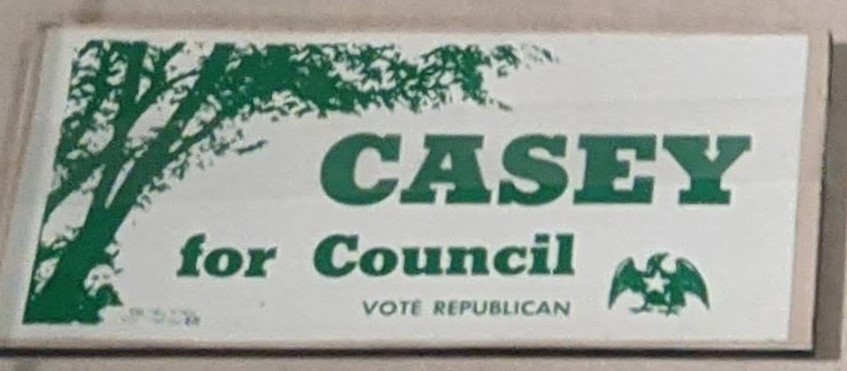
"[Andrew J.] Casey for Council vote Republican" bumper sticker
Creator unknown
“[Andrew J.] Casey for Council vote Republican” bumper sticker
Jerome O. Herlihy political campaign ephemera collection
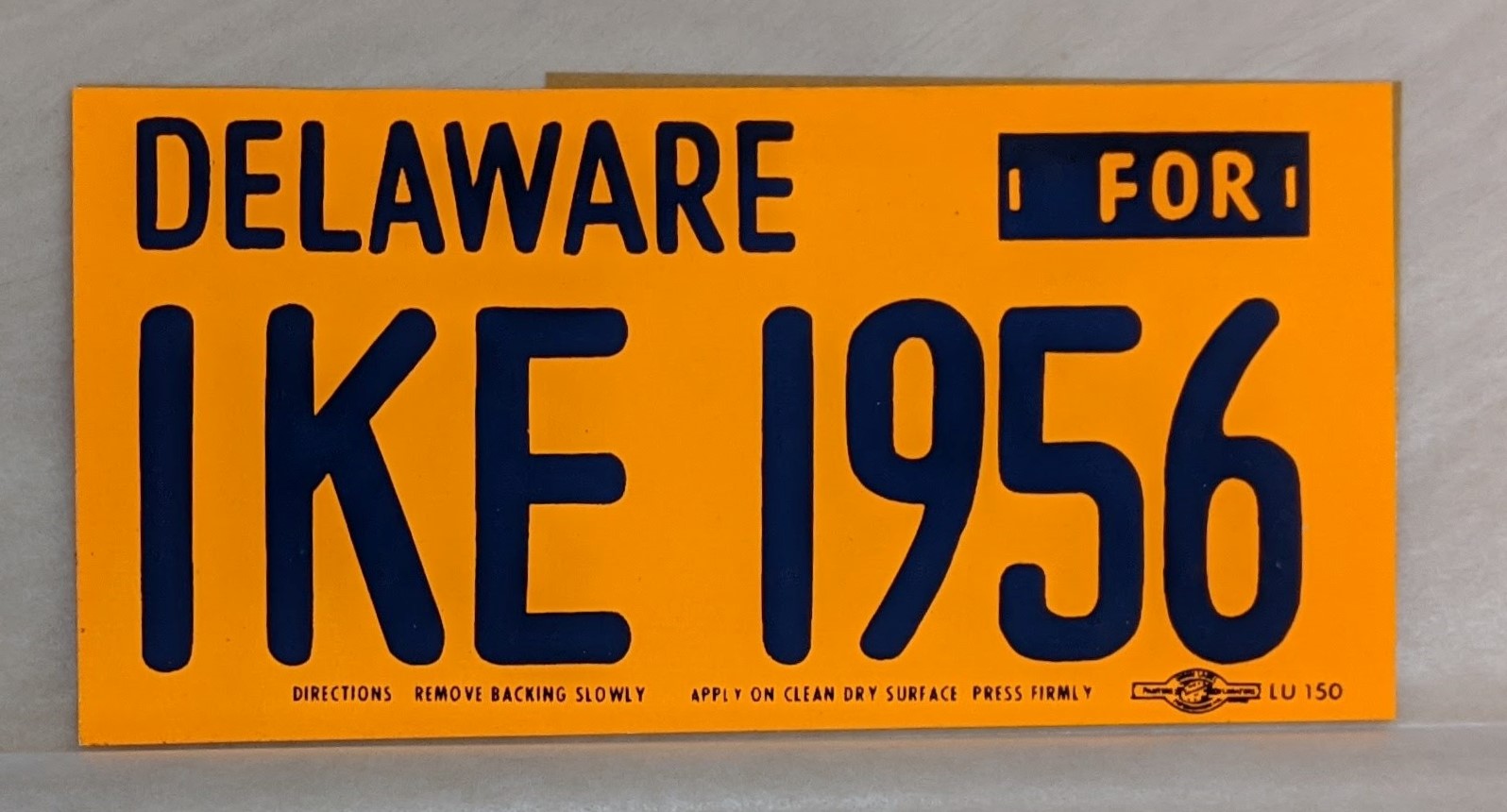
"Delaware for Ike 1956" bumper sticker, 1956
Creator unknown
“Delaware for Ike 1956” bumper sticker, 1956
Jerome O. Herlihy political campaign ephemera collection

"[Henry] Folsom for President of [New Castle County] Council" bumper sticker, circa 1972
Creator unknown
“[Henry] Folsom for President of [New Castle County] Council” bumper sticker, circa 1972
Jerome O. Herlihy political campaign ephemera collection
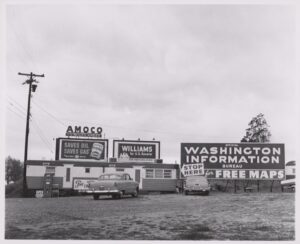
Campaign billboards, 1958
Creator unknown
Campaign billboards, 1958
Photograph
Senator John J. Williams papers

"[Sherman] Tribbitt for Governor" bumper sticker, 1972
Creator unknown
“[Sherman] Tribbitt for Governor” bumper sticker, 1972
Jerome O. Herlihy political campaign ephemera collection

"I like Bill Roth for Congress" bumper sticker, 1966-1968
Creator unknown
“I like Bill Roth for Congress” bumper sticker, 1966-1968
Jerome O. Herlihy political campaign ephemera collection

"Women's equality is economic equality. Women for Reagan-Bush '84" bumper sticker, 1984
Creator unknown
“Women’s equality is economic equality. Women for Reagan-Bush ’84” bumper sticker, 1984
Jerome O. Herlihy political campaign ephemera collection
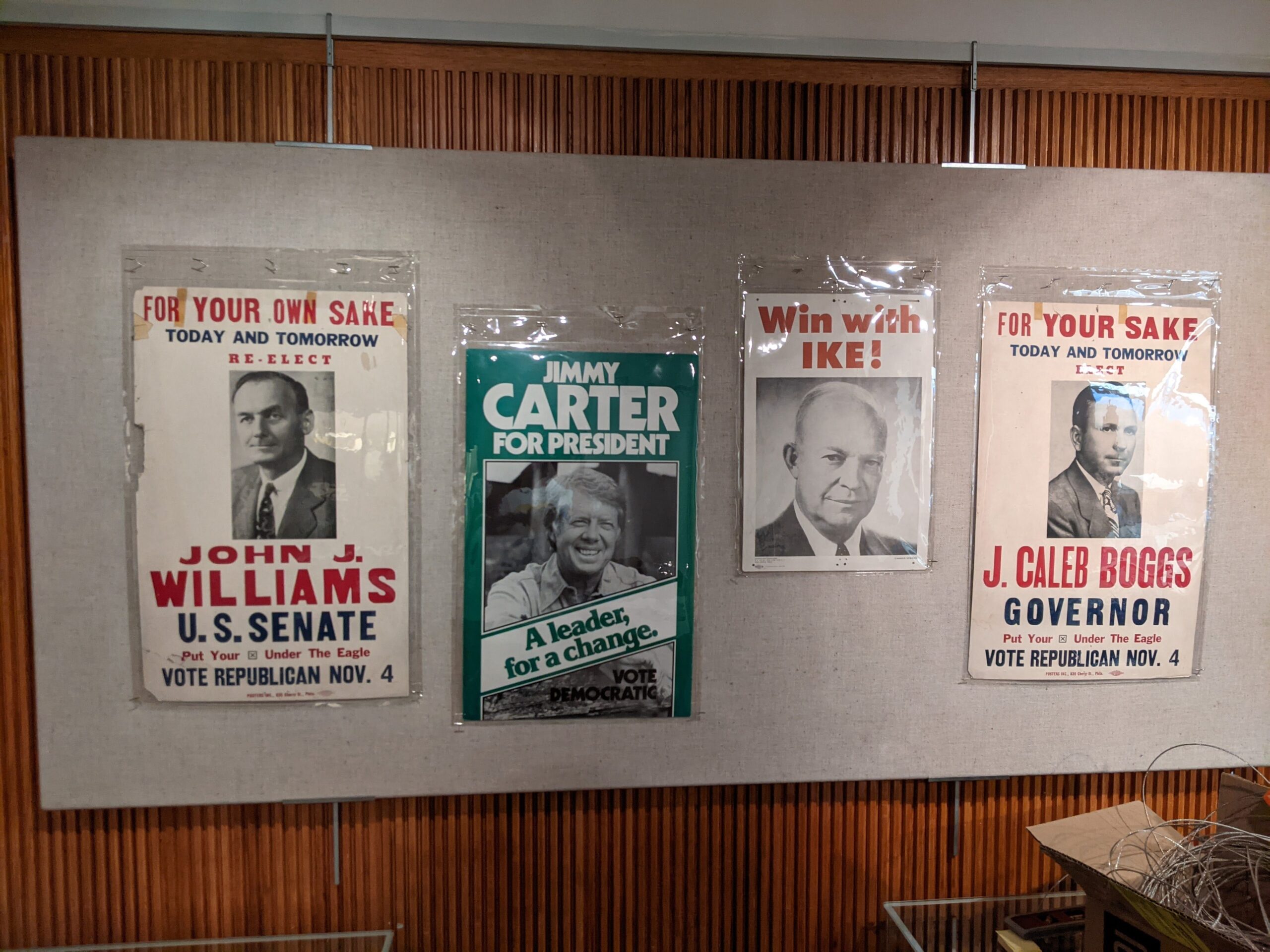
Political posters
From left to right:
1. Creator unknown
“For your sake today and tomorrow, vote John J. Williams, U. S. Senate… Vote Republican November 4 [1952]” campaign poster, 1952
Jerome O. Herlihy political campaign ephemera collection
2. Creator unknown
“Jimmy Carter for President. A leader, for a change. Vote Dmeocratic.” campaign poster, circa 1976
Delaware ephemera collection relating to politics, policy and government
3. Creator unknown
“Win with Ike!” campaign poster, circa 1952
Jerome O. Herlihy political campaign ephemera collection
4. Creator unknown
“For your sake today and tomorrow, vote J. Caleb Boggs Governor… Vote Republican November 4 [1952]” campaign poster, 1952
Jerome O. Herlihy political campaign ephemera collection

Campaign signs
From left to right:
1. Creator unknown
“Lisa Blunt Rochester. Democrat for Congress” campaign sign, 2018
Delaware ephemera collection relating to politics, policy and government
2. Creator unknown
“Ciferni for Mayor…” campaign sign, 2019
Delaware ephemera collection relating to politics, policy and government
3. Creator unknown
“Vote for Jeffrey Day. Christina School Board” campaign sign, May 7, 2017
Delaware ephemera collection relating to politics, policy and government
4. Creator unknown
“Bethany Hall-Long, Lieutenant Governor, Democrat” campaign sign, 2016
Delaware ephemera collection relating to politics, policy and government
5. Creator unknown
“James Spadola, State Auditor” campaign sign, 2018
Delaware ephemera collection relating to politics, policy and government
6. Creator unknown
“Vote Demitri Theodoropoulos U.S. Senate 2018…” campaign sign, 2018
Delaware ephemera collection relating to politics, policy and government
7. Creator unknown
“Putting people first. Re-elect Michael Kozikowski, NCC [New Castle County] Recorder of Deeds” campaign sign, 2018
Delaware ephemera collection relating to politics, policy and government
8. Creator unknown
“John Kowalko – Democrat, 25th State Representative District” campaign sign, 2018
Delaware ephemera collection relating to politics, policy and government
Cases 11, 12, and 13: Campaign apparel and accessories
Clothing and jewelry are ways that people express themselves and their preferences. As a result, campaigns (and private citizens) have come up with a variety of ways to show their support for candidates and causes through wardrobe.

Mike Castle for Senate tee shirt, front, 2010
Hanes Corporation
Mike Castle for Senate tee shirt, 2010
Cotton
Delaware ephemera collection related to politics, policy and government
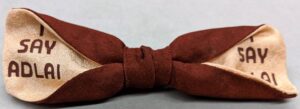
Adlai Stevenson Clip-on bow tie, No date
Creator unknown
Adlai Stevenson Clip-on bow tie, No date
Jerome O. Herlihy political campaign ephemera collection
Ties are one of the ways that men can show flair in their wardrobe, and are an avenue for political expression.
More about this item
"Vote for Nixon" arm band, 1960
Creator unknown
“Vote for Nixon” arm band, 1960
Jerome O. Herlihy political campaign ephemera collection
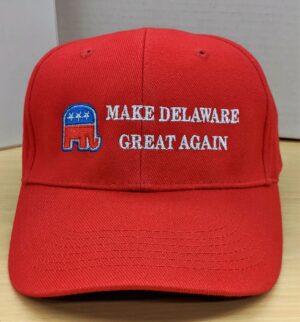
"Make Delaware Great Again" baseball cap, 2018
Port & Company
“Make Delaware Great Again” baseball cap, 2018
Jerome O. Herlihy political campaign ephemera collection
Hats have always been a common way to display political preference, particularly at rallies and national conventions.
More about this item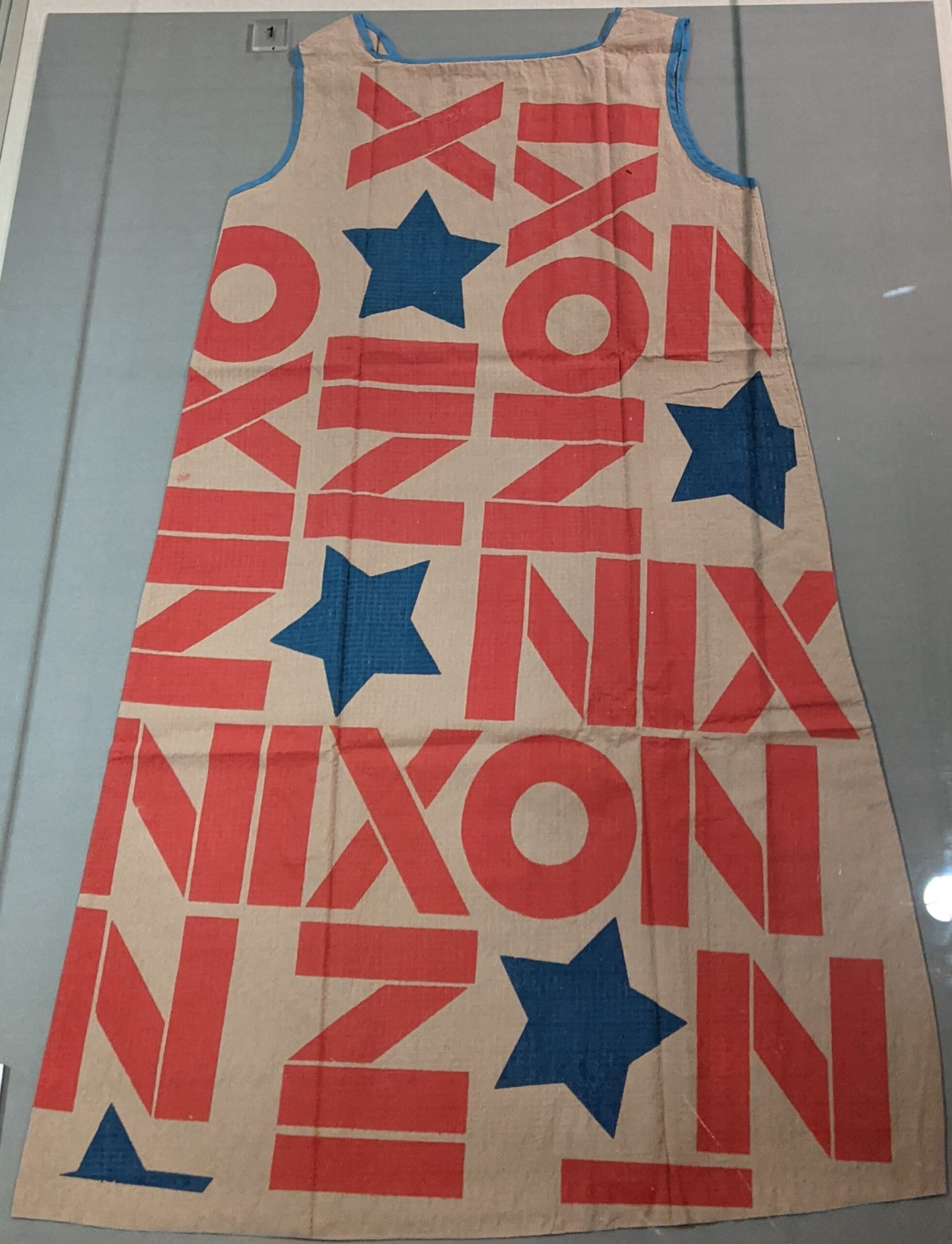
Paper Nixon Campaign Dress, 1968
Mars of Asheville, N.C.
Paper Nixon Campaign Dress, 1968
Cellulose
While cotton shirts are common, in the 1960s, paper dresses were a fad. Originally created by the Scott Paper Company, these cellulose buffered fabric allowed manufacturers to create “disposable” clothes that were somewhat fire and weather-resistant. Paper dresses embodied the pop culture and commercialism mindset of mid-century America. The trend extended to politics, as seen in the Mars Company Nixon paper dress from the 1968 presidential campaign.
More about this item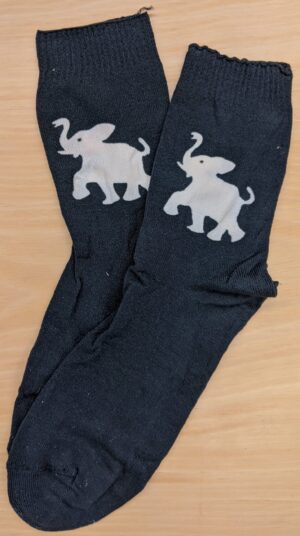
Republican-themed socks, No date
Creator unknown
Republican-themed socks, No date
Jerome O. Herlihy political campaign ephemera collection
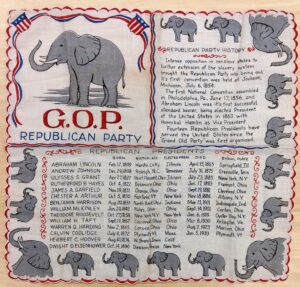
GOP handkerchief, No date
Creator unknown
GOP handkerchief, No date
Jerome O. Herlihy political campaign ephemera collection
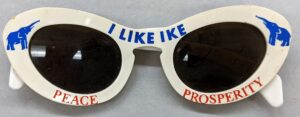
"I like Ike" plastic sunglasses, 1952
Creator unknown
“I like Ike” plastic sunglasses, 1952
Jerome O. Herlihy political campaign ephemera collection
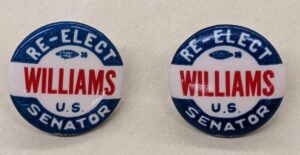
"Re-elect [John J.] Williams U.S. Senator" clip-on earrings, 1952-1964
Creator unknown
“Re-elect [John J.] Williams U.S. Senator” clip-on earrings, 1952-1964
Jerome O. Herlihy political campaign ephemera collection
Various accessories and jewelry (other than political buttons) have also become fun ways to show support for your preferred candidate.
More about this item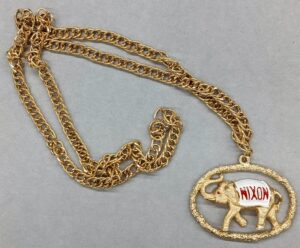
Nixon necklace with elephant, 1960
Creator unknown
Nixon necklace with elephant, 1960
Jerome O. Herlihy political campaign ephemera collection
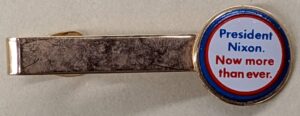
Nixon tie clip, 1972
Creator unknown
Nixon tie clip, 1972
Jerome O. Herlihy political campaign ephemera collection

"Eisenhower Day" honor guard sash, Kansas City, September 19, 1952
Creator unknown
“Eisenhower Day” honor guard sash, Kansas City, September 19, 1952
Jerome O. Herlihy political campaign ephemera collection
Case 14: Campaign memorabilia
Campaigns produce and distribute many items bearing the candidate’s name, likeness, and campaign slogan. Useable, consumable, and unique, the variety of memorabilia that campaigns and parties produce—and people can collect—is almost limitless.
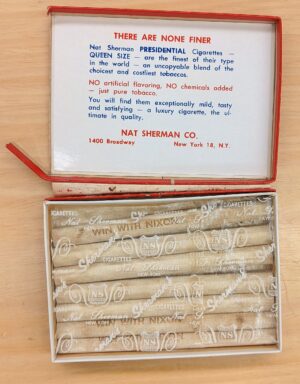
"Win with Nixon" Queen-sized cigarettes
Nat Sherman Co.
“Win with Nixon” Queen-sized cigarettes, 1968
Jerome O. Herlihy political campaign ephemera collection
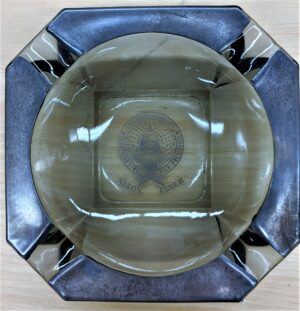
"Inauguration of President [Richard] Nixon and Vice President [Spiro] Agnew" ashtray
Creator unknown
“Inauguration of President [Richard] Nixon and Vice President [Spiro] Agnew” ashtray, 1969-1973
Jerome O. Herlihy political campaign ephemera collection
![John Pillsbury for Governor [Republican - New Hampshire], No date](https://exhibitions.lib.udel.edu/trail-to-the-voting-booth/wp-content/uploads/sites/97/2021/02/PIllsbury_matchbook.jpg )
John Pillsbury for Governor [Republican - New Hampshire], No date
D.D. Bean & Sons Co.
John Pillsbury for Governor [Republican – New Hampshire], No date
Jerome O. Herlihy political campaign ephemera collection
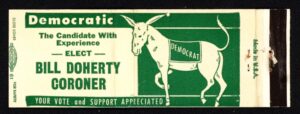
Bill Doherty, Democratic candidate for Coroner matchbook
Creator unknown
Bill Doherty, Democratic candidate for Coroner matchbook
Jerome O. Herlihy political campaign ephemera collection
![[Perkins] Bass for U.S. Senate matchbook, interior, No date](https://exhibitions.lib.udel.edu/trail-to-the-voting-booth/wp-content/uploads/sites/97/2021/02/Bass_matchbook_interior.jpg )
[Perkins] Bass for U.S. Senate matchbook, interior, No date
D.D. Bean & Sons Co.
[Perkins] Bass for U.S. Senate matchbook, interior, No date
Jerome O. Herlihy political campaign ephemera collection

Senator Chris Coons bobble head
Destroyer Promotional Products
Senator Chris Coons bobble head, Wilmington Blue Rocks
Delaware ephemera collection related to politics, policy, and government

Lisa Blunt Rochester, Democrat for Congress water bottle, 2016
Creator unknown
Lisa Blunt Rochester, Democrat for Congress water bottle, 2016
Delaware ephemera collection related to politics, policy, and government
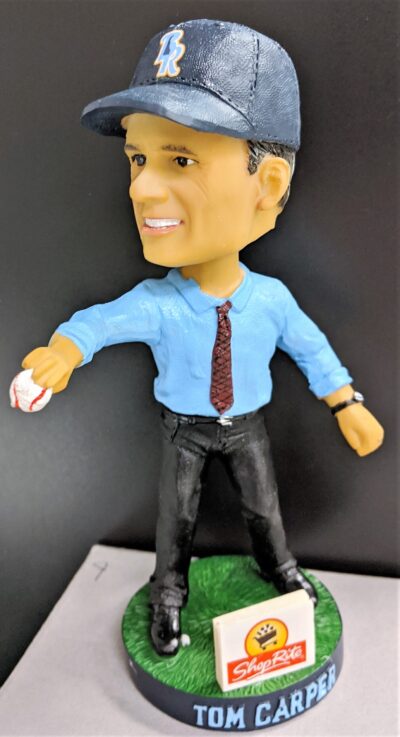
Senator Thomas R. Carper bobble head, Wilmington Blue Rocks
Alexander Global Promotions (Bellevue, WA)
Senator Thomas R. Carper bobble head, Wilmington Blue Rocks
Delaware ephemera collection related to politics, policy, and government
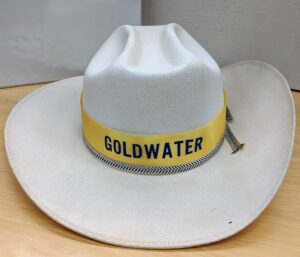
Goldwater Stetson hat, 1964
Unknown creator,
Goldwater Stetson hat, 1964
Jerome O. Herlihy political campaign ephemera collection
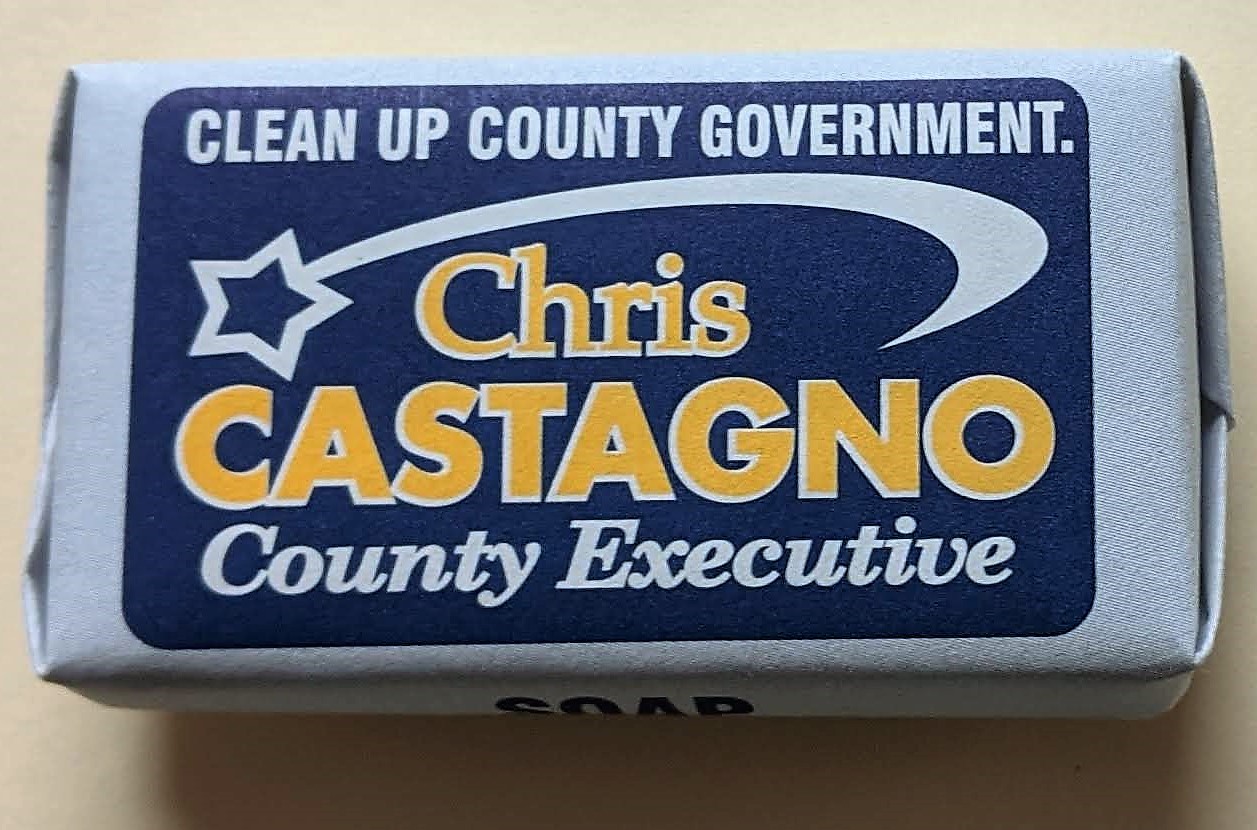
"Chris Castagno, [New Castle] County Executive" soap bar, 2004
Creator unknown
“Chris Castagno, [New Castle] County Executive” soap bar, 2004 University of Delaware ephemera collection related to politics, policy, and government
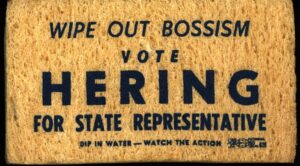
"Wipe out Bossism, Vote [George C.] Hering [III] for State Representative" sponge
Creator unknown
“Wipe out Bossism, Vote [George C.] Hering [III] for State Representative” sponge, 1966-1972
Jerome O. Herlihy political campaign ephemera collection
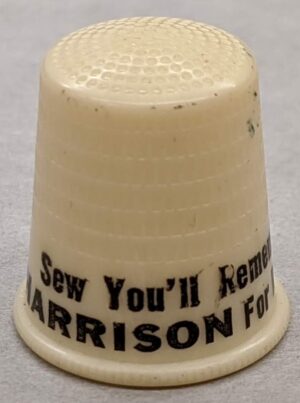
"Sew You'll Remember Clayt Harrison for Recorder of Deeds" thimble, No date
Creator unknown,
“Sew You’ll Remember Clayt Harrison for Recorder of Deeds” thimble
Jerome O. Herlihy political campaign ephemera collection

"[Walter] Bacon for Governor" thimble, 1940-1948
Creator unknown
“[Walter] Bacon for Governor” thimble, 1940-1948
Jerome O. Herlihy political campaign ephemera collection
![Vote [Elbert] Carvel for Governor nail file, circa 1948-1960](https://exhibitions.lib.udel.edu/trail-to-the-voting-booth/wp-content/uploads/sites/97/2020/09/carvel_nail_file.jpg )
Vote [Elbert] Carvel for Governor nail file, circa 1948-1960
Creator unknown
Vote [Elbert] Carvel for Governor nail file, circa 1948-1960
Jerome O. Herlihy political campaign ephemera collection

"Mondale/Ferraro, They won't rub you the wrong way!" nail file, 1988
Mondale/Ferraro Committee
“Mondale/Ferraro, They won’t rub you the wrong way!” nail file, 1988
Jerome O. Herlihy political campaign ephemera collection
![[Daniel T.] Pennell, [Jr.,] for [State] Senate comb, 1970](https://exhibitions.lib.udel.edu/trail-to-the-voting-booth/wp-content/uploads/sites/97/2020/09/pennell_comb-scaled-e1600042152734.jpg )
[Daniel T.] Pennell, [Jr.,] for [State] Senate comb, 1970
Creator unknown
[Daniel T.] Pennell, [Jr.,] for [State] Senate comb, 1970
Jerome O. Herlihy political campaign ephemera collection
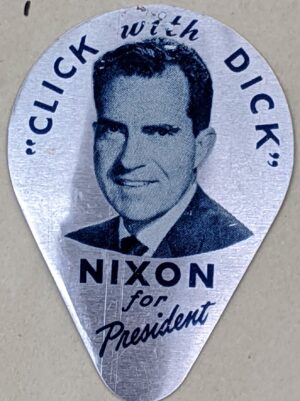
"Click with Dick" [Richard] Nixon for President clicker/noise maker
Creator unknown
“Click with Dick” [Richard] Nixon for President clicker/noise maker
Jerome O. Herlihy political campaign ephemera collection

Dwight D. Eisenhower fan in the shape of Eisenhower's face, circa 1955
Creator unknown
Dwight D. Eisenhower fan in the shape of Eisenhower’s face, circa 1955
Jerome O. Herlihy political campaign ephemera collection
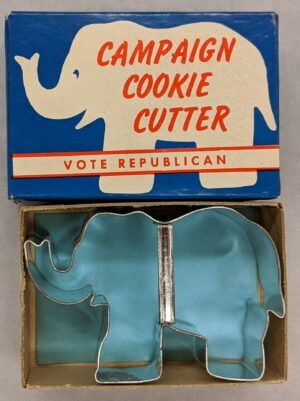
"Vote Republican" campaign cookie cutter
Creator unknown
“Vote Republican” campaign cookie cutter
Jerome O. Herlihy political campaign ephemera collection
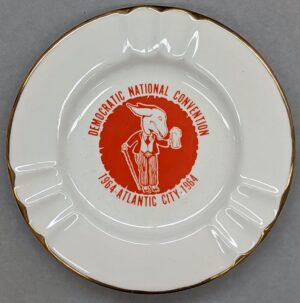
1964 Democratic National Convention, Atlantic City, plate, 1964
Creator unknown
1964 Democratic National Convention, Atlantic City, plate, 1964
Jerome O. Herlihy political campaign ephemera collection
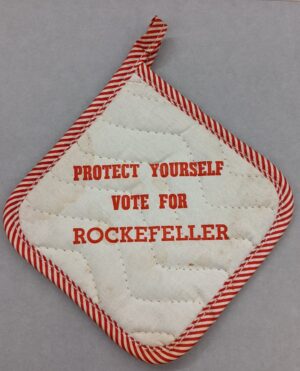
"Protect yourself vote for [Nelson] Rockefeller" potholder, circa 1964
Creator unknown
“Protect yourself vote for [Nelson] Rockefeller” potholder, circa 1964
Jerome O. Herlihy political campaign ephemera collection

"Vote Republican. [Caleb] Boggs for U.S. Senate, John W. Rollins for Governor" paddle ball, 1960
Bo-Lo (Atlanta, Ga.)
“Vote Republican. [Caleb] Boggs for U.S. Senate, John W. Rollins for Governor” paddle ball, 1960
Jerome O. Herlihy political campaign ephemera collection

"Ike's Story" comic book, circa 1952
Sponsored Comics, Inc
“Ike’s Story” comic book, circa 1952
Jerome O. Herlihy political campaign ephemera collection
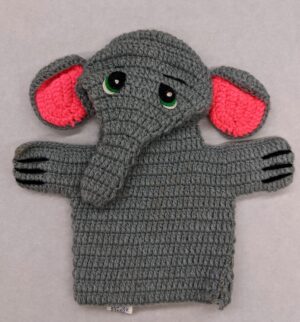
Elephant hand puppet
R. Dakin & Co.
Elephant hand puppet
Jerome O. Herlihy political campaign ephemera collection
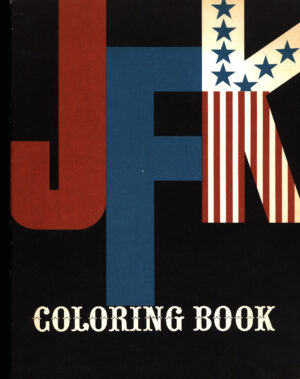
JFK Coloring Book, circa 1961
Creator unknown
JFK Coloring Book, circa 1961,
Jerome O. Herlihy political campaign ephemera collection
Case 15: Political conventions
Political conventions serve two important functions: setting the platform, and formally selecting a nominee.
The first political conventions date back to the early nineteenth century, when party leaders would hold secret meetings to select candidates from office. The earliest convention that we would recognize was held in Baltimore, Maryland, in 1831, when the Anti-Masonic party met to formally debate and select a nominee for the 1832 presidential election. In the late nineteenth century and early twentieth centuries, the heyday of the political machine, the convention may have been public, but party bosses and important elected officials still dictated much in terms of party platform and nominee. During this period, political parties resembled coalitions with heated factions fighting for dominance.
The modern political conventions began in the mid-twentieth century, around the same time as the modern primary system, where rank-and-file party members, instead of party elites, began exercising more control in the process.

Photograph of Thomas J. Herlihy, Jr., and others en route to the 1936 Republican National Convention in Cleveland, OH
Creator unknown
Photograph of Thomas J. Herlihy, Jr., and others en route to the 1936 Republican National Convention in Cleveland, OH,
Jerome O. Herlihy political campaign ephemera collection
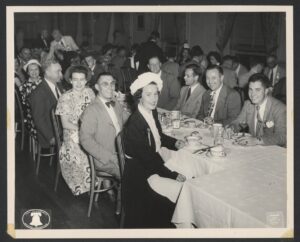
National Democratic Convention Dinner, (Delaware Chapter). Mr. and Mrs. Gordon Smith, Senator and Mrs. Frear, Mrs. Harris McDowell, Mr. Jack Schwab, Mr. William Potter, Mr. Stein, and Mr. Robert F. Kelly, July 1948
Creator unknown
National Democratic Convention Dinner, (Delaware Chapter). Mr. and Mrs. Gordon Smith, Senator and Mrs. Frear, Mrs. Harris McDowell, Mr. Jack Schwab, Mr. William Potter, Mr. Stein, and Mr. Robert F. Kelly, July 1948
Photograph
Senator J. Allen Frear, Jr., papers
Political conventions provide opportunities for party members to gather socially, as well as for party business, as can be seen in this photo from the 1948 Democratic Convention.
More about this item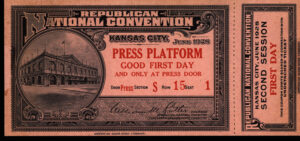
1928 Convention Press Ticket, June 1928
Republican National Convention
1928 Convention Press Ticket, June 1928
Harold Brayman papers
The press covers the convention, the excitement—and the drama—of the party, and helps drive the narrative of the general election. Increased press coverage of political conventions has been cited as a key factor in increasing interest in presidential politics in the latter half of the twentieth century.
More about this item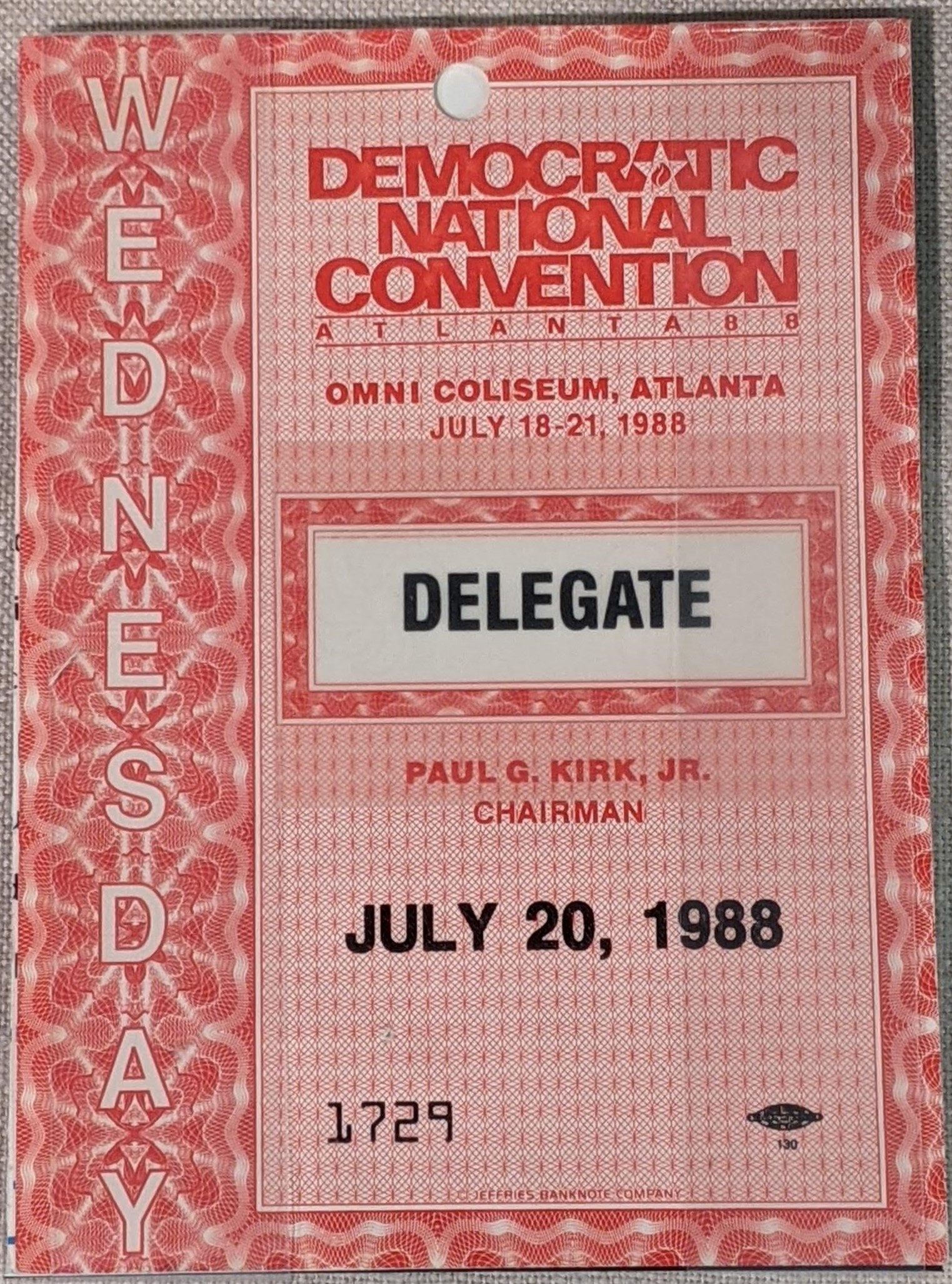
Democratic National Convention 1988 delegate badge for Wednesday, July 20, 1988
Democratic National Committee
Democratic National Convention 1988 delegate badge for Wednesday, July 20, 1988
Jerome O. Herlihy political campaign ephemera collection

1988 Democratic National Convention button, 1988
Creator unknown
1988 Democratic National Convention button, 1988
Jerome O. Herlihy political campaign ephemera collection
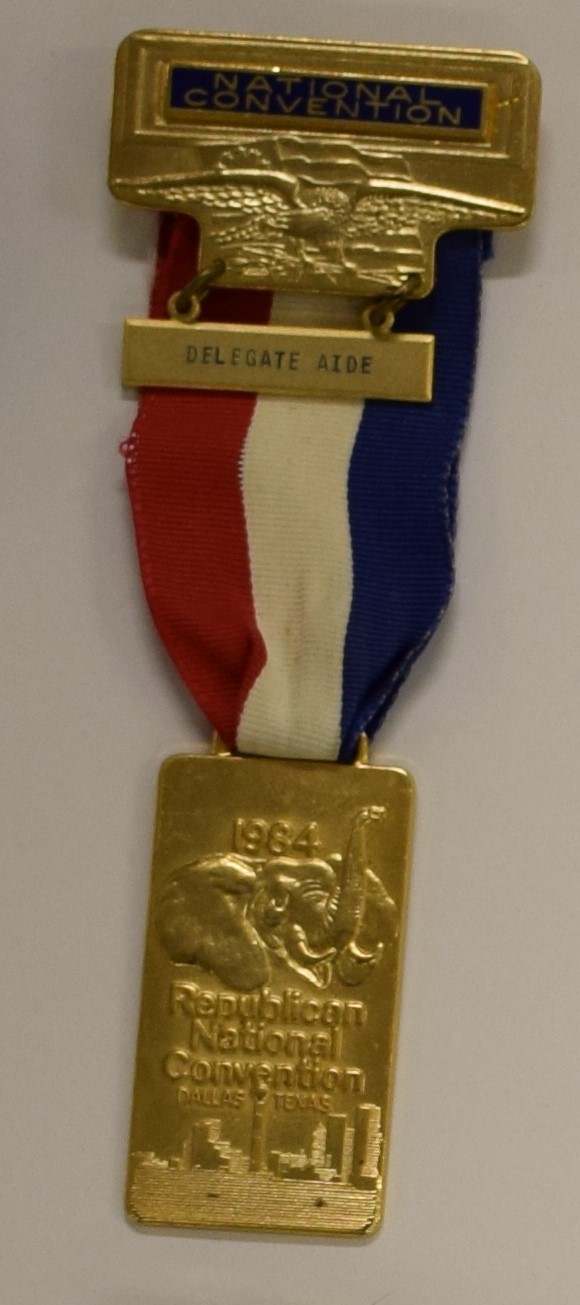
1964 Republican National Convention Delegate Aide pin, 1964
Creator unknown
1964 Republican National Convention Delegate Aide pin, 1964
Jerome O. Herlihy political campaign ephemera collection

Caucuses of 1860: A History of the National Political Conventions of the Current Presidential Campaign: Being a Complete Record of the Business of All the Conventions; with Sketches of Distinguished Men in Attendance Upon Them, and Descriptions of the Most Characteristic Scenes and Memorable Events, 1860
Halstead, Murat, et al.
Caucuses of 1860: A History of the National Political Conventions of the Current Presidential Campaign: Being a Complete Record of the Business of All the Conventions; with Sketches of Distinguished Men in Attendance Upon Them, and Descriptions of the Most Characteristic Scenes and Memorable Events.
Follett, Foster and Company, 1860.
While conventions have necessary and official business to conduct, they are also opportunities for party members from all over the country to come together, listen to party officials and leaders deliver energizing speeches, and, ideally, embrace the nominee for a unified general election campaign.
More about this item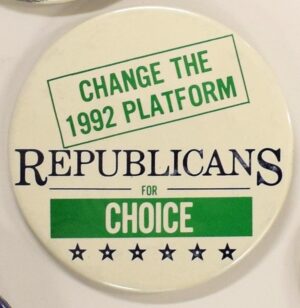
"Change the Platform / Republicans for Choice" button, 1992
Creator unknown
“Change the Platform / Republicans for Choice” button, 1992
Jerome O. Herlihy political campaign ephemera collection
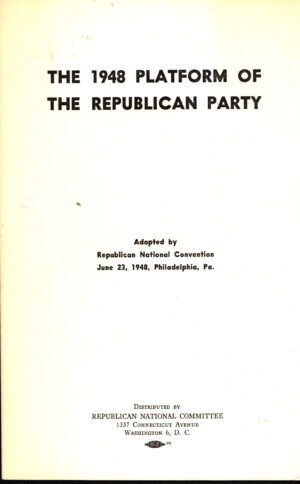
1948 Republican National Committee Party Platform, 1948
Republican National Committee
1948 Republican National Committee Party Platform, 1948
Jerome O. Herlihy political campaign ephemera collection
Delegates to the convention discuss, debate, and vote on the party platform, the officially endorsed governing philosophy and policy priorities for the party. For the national party, the presidential nominee, and their policy preferences, wields a lot of influence in the final construction in the platform. State level party organizations also create a platform reflecting the accomplishments and goals of gubernatorial and state legislative candidates and incumbents.
More about this item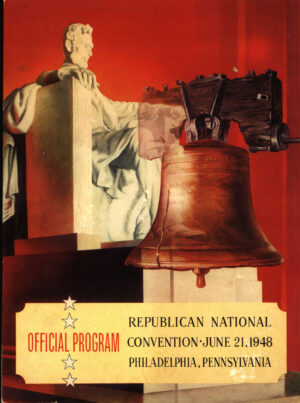
Official Program for the 1948 Republican National Convention, June 21, 1948
Republican National Convention,
Official Program for the 1948 Republican National Convention, June 21, 1948
Jerome O. Herlihy political campaign ephemera collection
In terms of national politics, the most important function of the Democrat and Republican National Conventions is to formally vote and endorse a candidate for President of the United States. Delegates from every state and territory cast votes for the party’s standard-bearer. Even if the primary election process yields a clear winner, the convention officially names a nominee for the national general election.
Procedurally, members of the party officially put candidates into nomination, delegates vote on the eligible nominees, and the successful candidate formally accepts the nomination.
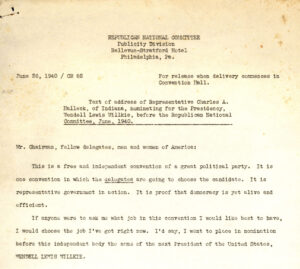
Nominating speech for Wendell Willkie for the Republican nomination for President of the United States, June 26, 1940
Charles A. Halleck
Nominating speech for Wendell Willkie for the Republican nomination for President of the United States, June 26, 1940
Harold Brayman papers
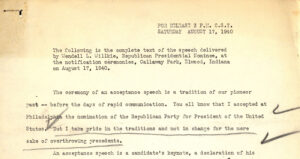
Acceptance Speech for the Republican Presidential Nominee, August 17, 1940
Wendell L. Willkie
Acceptance Speech for the Republican Presidential Nominee, August 17, 1940
Harold Brayman papers
Case 16: In the Voting Booth
As election day approaches, voters who cannot make it to the polls in person need to apply for an absentee ballot. Others many need to update their registration in order to vote.
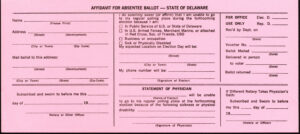
Affidavit for Absentee Ballot
State of Delaware
Affidavit for Absentee Ballot
Gwynne P. Smith papers
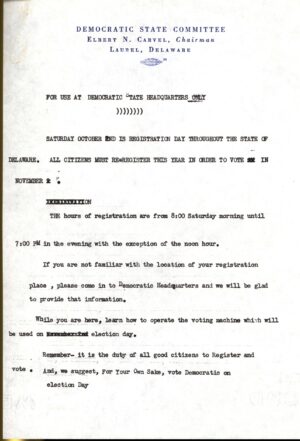
Radio announcement script with information for voter registration, October 1954
Delaware Democratic State Committee
Radio announcement script with information for voter registration, October 1954
Senator J. Allen Frear, Jr., papers

"I Voted for the next President" sticker
Creator unknown
“I voted for the next President” sticker
Delaware ephemera collection related to politics, policy, and government
"Get out and vote! Or forever hold your peace!" cartoon, Wilmington News Journal, November 5, 1996
Jack Jurden
“Get out and vote! Or forever hold your peace!” cartoon, Wilmington News Journal, November 5, 1996
Jack Jurden political and editorial cartoons
An essential function for campaigns in the final days leading up to Election Day is to “get out the vote,” ensuring the people know where their polling places are located, the hours of voting, and who is on the ballot.
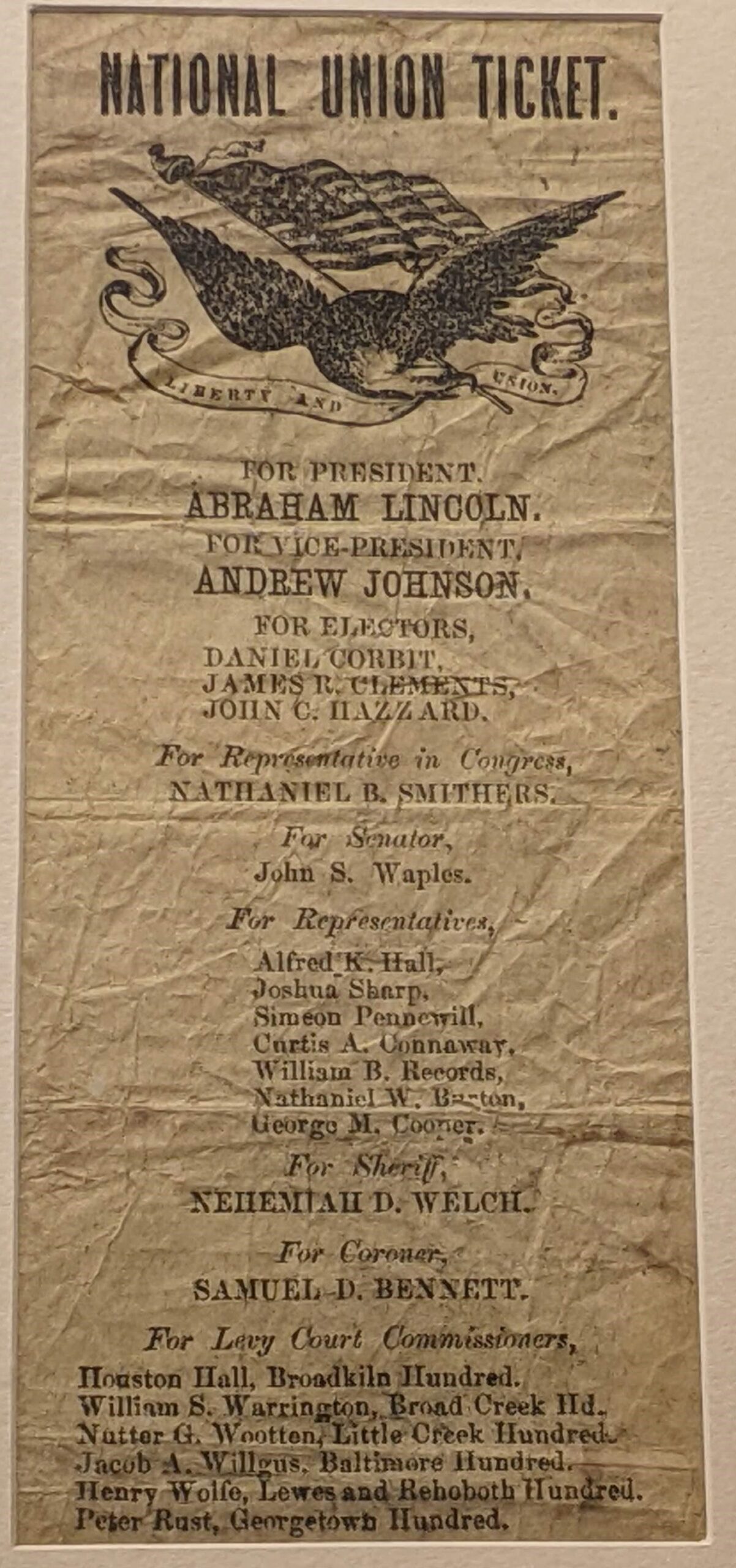
1864 Delaware general election sample ballot for the National Union Ticket, 1864
Creator unknown
1864 Delaware general election sample ballot for the National Union Ticket, 1864
Ron Finch collection
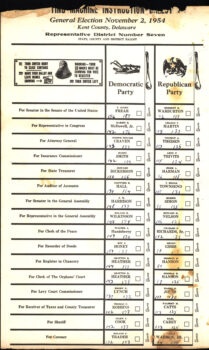
Sample Ballot, 1954
Creator unknown
Sample Ballot, 1954
Robert J. Voshell collection of Delaware political ephemera scrapbooks
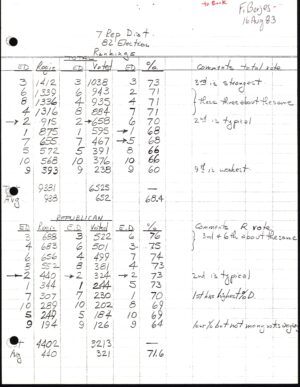
Voter Turnout Tally from the 1982 election, 7th representative district, August 16 1983
Gwynne Smith
Voter Turnout Tally from the 1982 election, 7th representative district, August 16 1983
Gwynne P. Smith papers
Once the polls close, the vote counting starts. Campaigns keep their own tallies at various precincts in their districts, in addition to the official counts reported to the Board of Elections.
More about this item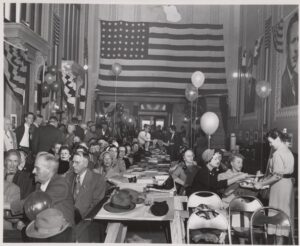
Republican Headquarters in Wilmington, Delaware, November 1952
Lubitsh & Bungarz Promotional Photography
Republican Headquarters in Wilmington, Delaware, November 1952
Photograph
Senator John J. Williams papers
Party officials and candidates gather at campaign headquarters to monitor the vote counts, celebrate candidate victories, and commiserate in electoral defeat.
More about this item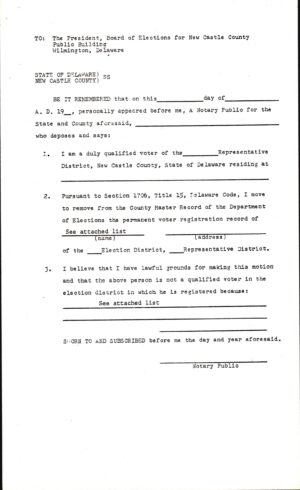
Voter Disqualification Form
Board of Elections for New Castle County
Voter Disqualification Form
Gwynne P. Smith papers
Access to voting is an important issue, not just for the candidates, but for those who administer elections as well. Election officials provide valuable information to make sure everyone who can vote is able to do so. They also give candidates a way to disqualify potentially improper votes.
More about this itemCase 17: Return Day
The State Law of 1791 moved the county seat in Sussex County from Lewes to a more centrally located area of the county, later naming the town Georgetown after one of the leading voices in relocating the county seat further inland. At that time, voters were required to go to the courthouse in Georgetown to cast their votes for local, state, and federal office. Two days later, voters returned to hear the results read out and certified. This was the birth of the unique Delaware tradition—Return Day.
Since 1812, Return Day has been celebrated in Georgetown. Both successful and unsuccessful candidates descend on the town to close out election season in Delaware in a show of unity. Members-elect and their opponents, Democrats and Republicans for both state and local office come together for the parade through town, former opponents riding together in carriages and floats (though the losers are traditionally seated backwards), before hearing the official Sussex County vote tally in front of the courthouse. After the votes are read, everyone buries the hatchet—literally. State party leaders bury a literal hatchet in sand from Lewes, Delaware, the original county seat, officially ending the campaign cycle in Delaware. Other activities of the day include an ox roast, free to all assembled, games, and opportunities to meet elected officials.
Part carnival, part campaign event, and part civil function, this unique Delaware tradition celebrates the best of American democracy—people from all walks of life coming together, setting their differences aside, and doing the people’s work.

Return Day cartoon, Wilmington News Journal, 2008
Jack Jurden
Return Day cartoon, Wilmington News Journal, 2008
Jack Jurden political and editorial cartoons collection

Return Day 1978 program, November 9, 1978
Creator unknown
Return Day 1978 program, November 9, 1978
Robert J. Voshell collection of Delaware political ephemera scrapbooks
"Delaware Rivals Join to Bury the Hatchet," New York Times, November 11, 1988
Richard L. Burke
“Delaware Rivals Join to Bury the Hatchet,” New York Times, November 11, 1988
Facsimile
Dale E. and Clarice Wolf paper and memorabilia
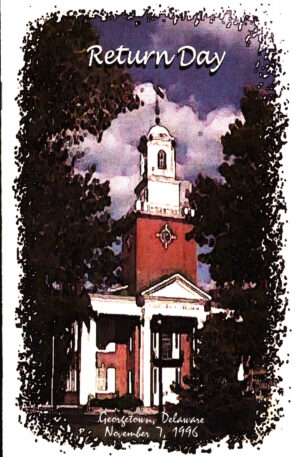
Return Day 1996 program, November 7, 1996
Creator unknown
Return Day 1996 program, November 7, 1996
Robert J. Voshell collection of Delaware political ephemera scrapbooks
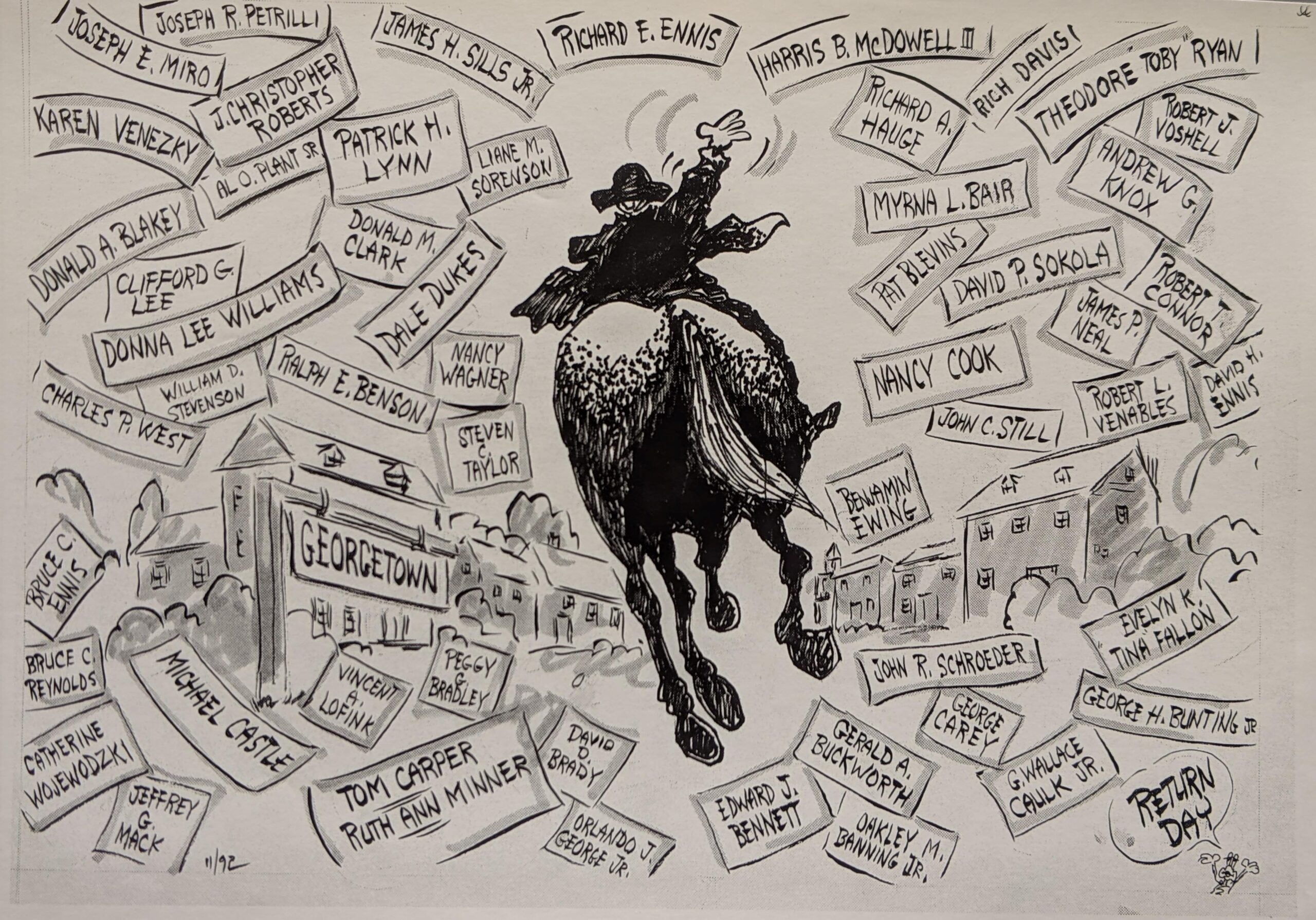
Return Day cartoon, Wilmington News Journal, 1996
Jack Jurden
Return Day cartoon, Wilmington News Journal, 1996
Jack Jurden political and editorial cartoons collection
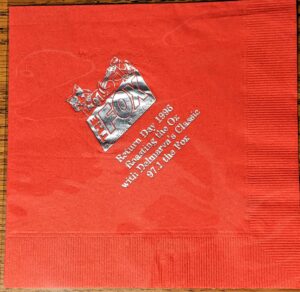
Return Day 1996 Ox Roast napkin, November 7, 1996
97.1 the Fox
Return Day 1996 Ox Roast napkin, November 7, 1996
University of Delaware ephemera collection related to politics, policy, and government
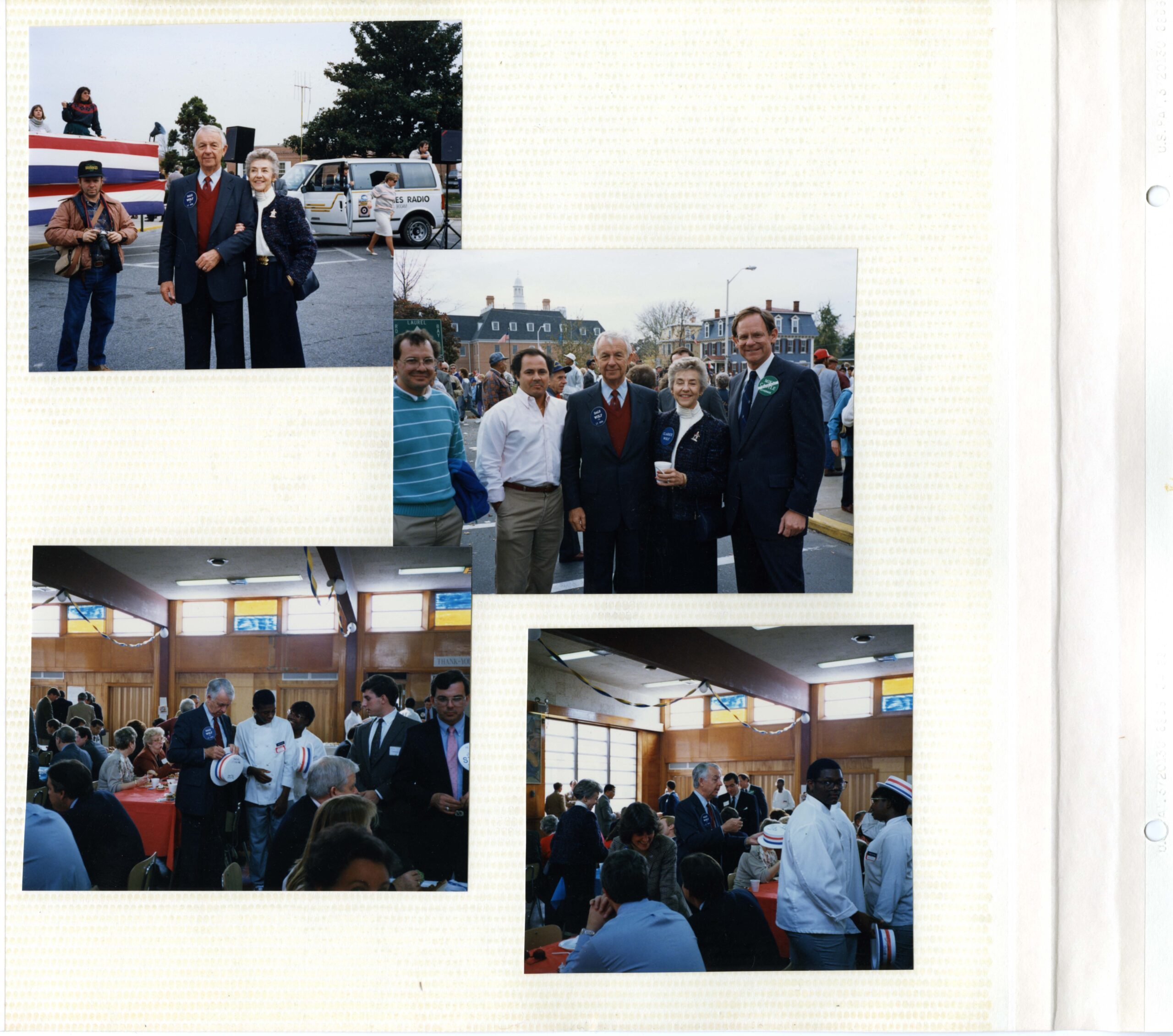
Photographs of Dale and Clarice Wolf on Return Day, November 10, 1988
Creator unknown
Photographs of Dale and Clarice Wolf on Return Day, November 10, 1988
Facsimile
Dale E. and Clarice Wolf papers and memorabilia

Photographs of Return Day, November 10, 1988
Creator unknown
Photographs of Return Day, November 10, 1988
Facsimile
Dale E. and Clarice Wolf papers and memorabilia

Photographs of Dale Wolf and Gary Hinds during the Return Day parade, November 10, 1988
Creator unknown
Photographs of Dale Wolf and Gary Hinds during the Return Day parade, November 10, 1988
Facsimile
Dale E. and Clarice Wolf papers and memorabilia
Case 18: Inaugurations and Swearing-Ins
Re-elected incumbents and candidates-elect get to celebrate their victories through inaugural activities and swearing-in ceremonies. Banquets, balls, parades, and speeches are all characteristic of inaugural ceremonies, which can last multiple days.
However, the most important part of the celebration is the swearing-in. All candidates have to take an oath of office, in which they promise to discharge the duties of their office. From this moment, they are public servants, entrusted by all of us to “faithfully execute the office [to which they are elected]… to the best of [their] ability.”
After all the excitement and ceremony, the one election cycle comes to a close. And another one begins…
![Inauguration of Governor [Richard] McMullen and Democratic State Government ribbon, January 19, 1937](https://exhibitions.lib.udel.edu/trail-to-the-voting-booth/wp-content/uploads/sites/97/2020/09/inauguration_mcmllen-e1599940249894.jpg )
Inauguration of Governor [Richard] McMullen and Democratic State Government ribbon, January 19, 1937
Creator unknown
Inauguration of Governor [Richard] McMullen and Democratic State Government ribbon, January 19, 1937
Jerome O. Herlihy political campaign ephemera collection
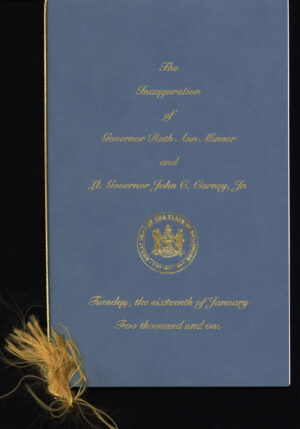
Program for the Inauguration of Governor Ruth Ann Minner and Lieutenant Governor John Carney, January 16, 2001
State of Delaware
Program for the Inauguration of Governor Ruth Ann Minner and Lieutenant Governor John Carney, January 16, 2001
Robert J. Voshell collection of Delaware political ephemera scrapbooks

Inauguration of Governor Caleb Boggs button, January 15, 1957
Creator unknown
Inauguration of Governor Caleb Boggs button, January 15, 1957
Jerome O. Herlihy political campaign ephemera collection

Gubernatorial Inaugural Ball: Senator and Mrs. Williams, Senator and Mrs. Frear, Governor and Mrs. Boggs, Others, January 15, 1957
Lubitsh & Bungarz Promotional Photography
Gubernatorial Inaugural Ball: Senator and Mrs. Williams, Senator and Mrs. Frear, Governor and Mrs. Boggs, Others, January 15, 1957
Photograph
Senator John J. Williams papers
![Delaware Delegation [to the] Inauguration of President [Dwight D.] Eisenhower ribbon, January 20, 1957](https://exhibitions.lib.udel.edu/trail-to-the-voting-booth/wp-content/uploads/sites/97/2020/09/del_del_inauguration_57-e1599940360427.jpg )
Delaware Delegation [to the] Inauguration of President [Dwight D.] Eisenhower ribbon, January 20, 1957
Creator unknown
Delaware Delegation [to the] Inauguration of President [Dwight D.] Eisenhower ribbon, January 20, 1957
Jerome O. Herlihy political campaign ephemera collection
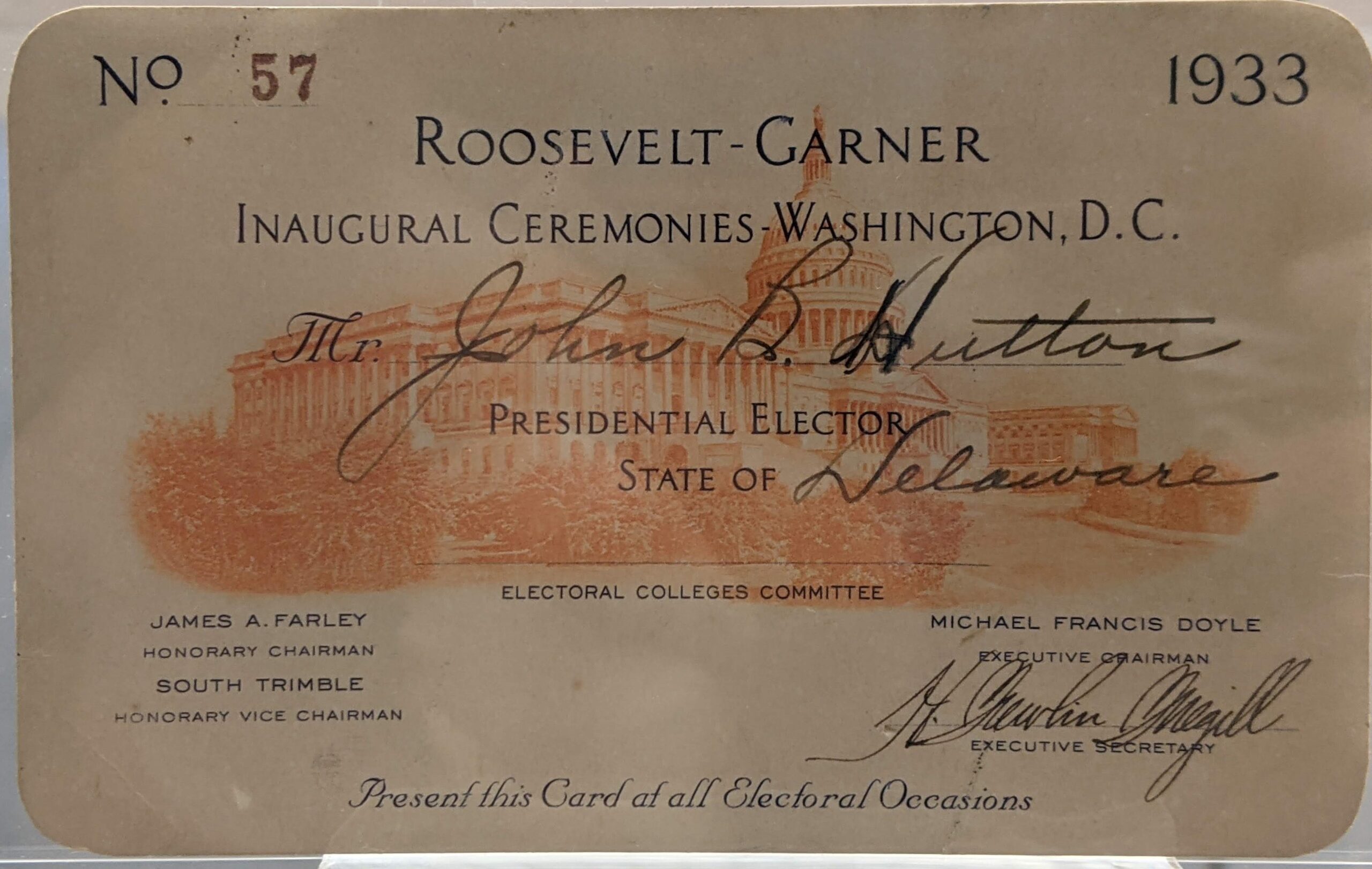
Ticket for John B. Hutton, Presidential Elector from the state of Delaware, to the Roosevelt-Garner Inaugural Ceremonies, March 1933
Creator unknown
Ticket for John B. Hutton, Presidential Elector from the state of Delaware, to the Roosevelt-Garner Inaugural Ceremonies, March 1933
John B. Hutton ticket to Roosevelt-Garner inaugural ceremonies
![Delaware Delegation for the Presidential Inauguration [of Herbert Hoover] pin, March 4, 1929](https://exhibitions.lib.udel.edu/trail-to-the-voting-booth/wp-content/uploads/sites/97/2020/09/inauguration_1929-e1599940117689.jpg )
Delaware Delegation for the Presidential Inauguration [of Herbert Hoover] pin, March 4, 1929
Whitehead & Hoag Co.
Delaware Delegation for the Presidential Inauguration [of Herbert Hoover] pin, March 4, 1929
Jerome O. Herlihy political campaign ephemera collection
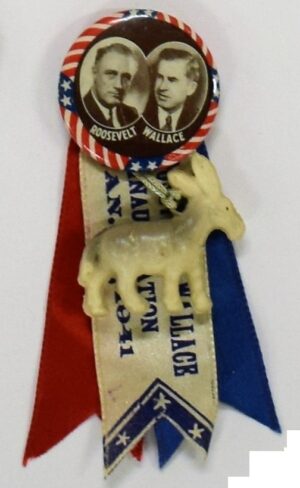
"[Franklin Delano] Roosevelt and [Henry] Wallace Inauguration ribbon with donkey medal, January 20, 1941
Garrison Toy & Novelty Company
“[Franklin Delano] Roosevelt and [Henry] Wallace Inauguration ribbon with donkey medal, January 20, 1941
Jerome O. Herlihy political campaign ephemera collection

Inaugural Address, March 4, 1933
Franklin D. Roosevelt
Inaugural Address, March 4, 1933
Harold Brayman papers
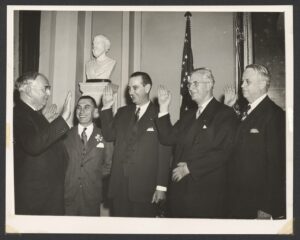
New Senators taking the oath of office. Senators Frear, Johnson, Douglas, Kerr, with Senator Vandenberg giving oath, January 3, 1949
Wide World Photos
New Senators taking the oath of office. Senators Frear, Johnson, Douglas, Kerr, with Senator Vandenberg giving oath, January 3, 1949
Photograph
Senator J. Allen Frear, Jr., papers
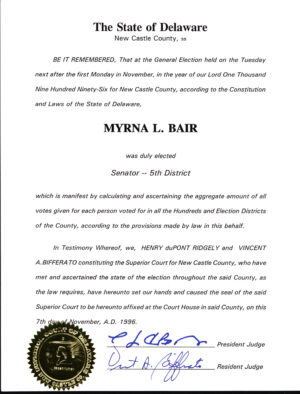
Certificate of Election for Myrna L. Bair, State Senate, 5th District, November 7, 1996,
State of Delaware
Certificate of Election for Myrna L. Bair, State Senate, 5th District, November 7, 1996
Myrna Bair papers
Certificates of election serve as the formal endorsement by the state that a candidate has won election. These certificates are presented before elected officials take their oaths of office.
More about this item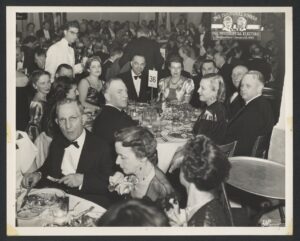
The Inaugural Dinner hosted by Harry S Truman and Alben Barkley, the Presidential electors. At table # 36: Mr. and Mrs. Gray, Mr. and Mrs. Grover, Mr. and Mrs. Freer, Senator and Mrs. Frear, Mr. Jacob Mays, and Senator and Mrs. Kerr, January 19, 1949
Schutz Photographer
The Inaugural Dinner hosted by Harry S Truman and Alben Barkley, the Presidential electors. At table # 36: Mr. and Mrs. Gray, Mr. and Mrs. Grover, Mr. and Mrs. Freer, Senator and Mrs. Frear, Mr. Jacob Mays, and Senator and Mrs. Kerr, January 19, 1949
Photograph
Senator J. Allen Frear, Jr., papers
![[John F.] Kennedy Inauguration Day, including Williams and former President Harry Truman, January 20, 1961](https://exhibitions.lib.udel.edu/trail-to-the-voting-booth/wp-content/uploads/sites/97/2020/09/kennedy_inauguration-e1599393360425.jpg )
[John F.] Kennedy Inauguration Day, including Williams and former President Harry Truman, January 20, 1961
Creator unknown
[John F.] Kennedy Inauguration Day, including Williams and former President Harry Truman, January 20, 1961
Photograph
Senator John J. Williams papers
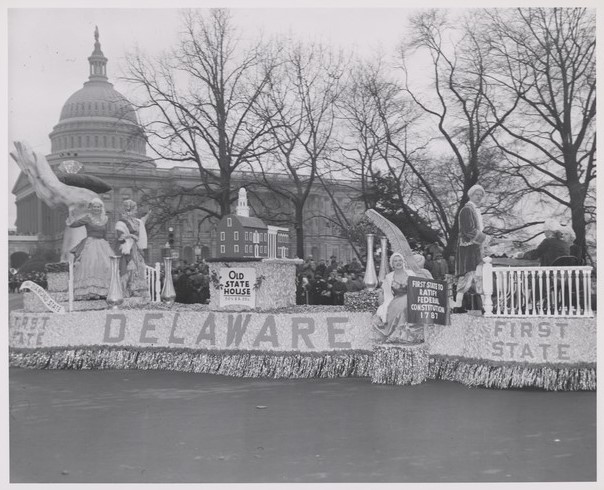
Eisenhower--Inaugural Parade, Delaware Float, Governor Boggs, January 21, 1957
Creator unknown
Eisenhower–Inaugural Parade, Delaware Float, Governor Boggs, January 21, 1957
Photograph
Senator John J. Williams papers
![Inauguration of President [Ronald] Reagan and Vice President [George H. W.]Bush seal, circa 1981-1985](https://exhibitions.lib.udel.edu/trail-to-the-voting-booth/wp-content/uploads/sites/97/2021/02/inaugural-seal-scaled.jpg )
Inauguration of President [Ronald] Reagan and Vice President [George H. W.]Bush seal, circa 1981-1985
Creator unknown
Inauguration of President [Ronald] Reagan and Vice President [George H. W.]Bush seal, circa 1981-1985
Jerome O. Herlihy political campaign ephemera collection
Front case items
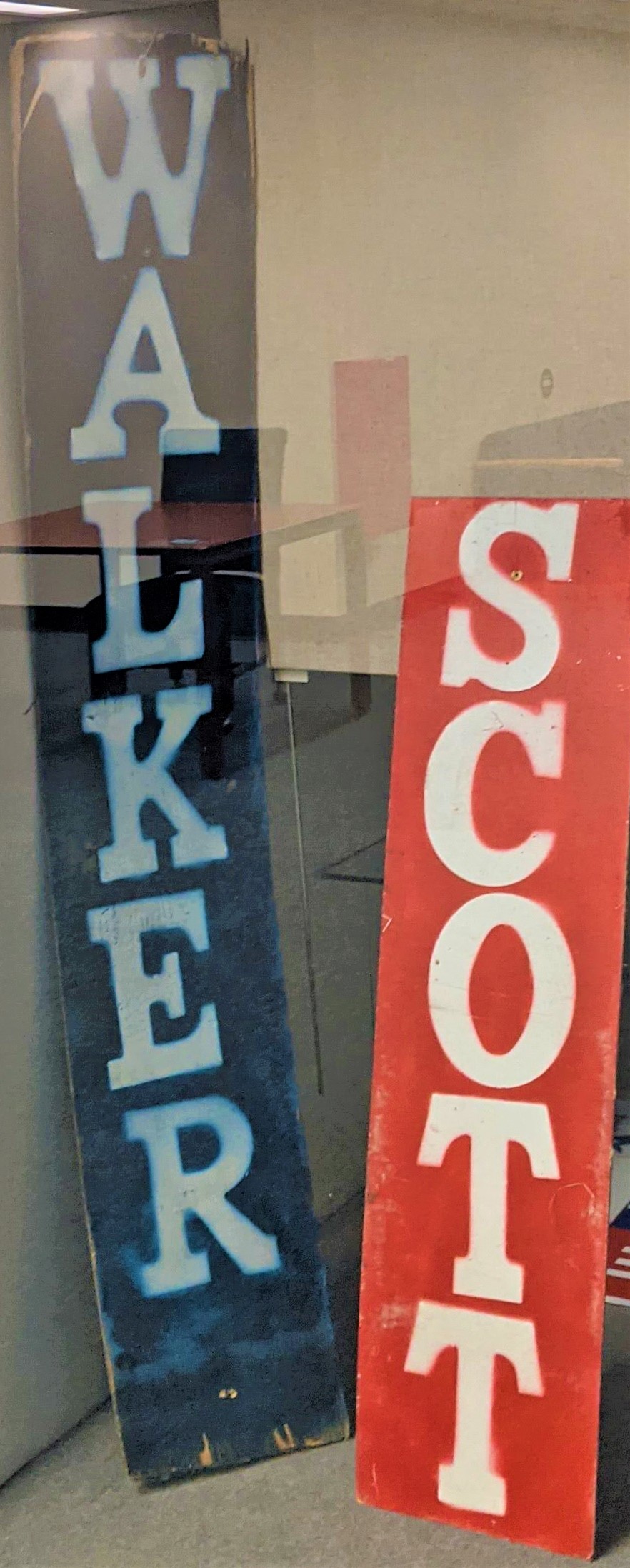
"[Scott] Walker [for Congress]" signs, 2018
Scott Walker
“[Scott] Walker [for Congress]” signs, 2018
Plywood
University of Delaware ephemera collection related to politics, policy and government

1984 Republican National Convention Delaware stanchion, 1984
Creator unknown
1984 Republican National Convention Delaware stanchion, 1984
Jerome O. Herlihy political campaign ephemera collection

1960 Republican National Convention Delaware stanchion, 1960
Creator unknown
1960 Republican National Convention Delaware stanchion, 1960
Jerome O. Herlihy political campaign ephemera collection

J. Edward Addicks Club of Delaware ribbon, 1900
Creator unknown,
J. Edward Addicks Club of Delaware ribbon, 1900
Ron Finch collection
Addicks was a businessman and pioneer in the natural gas industry, known for attempting to gain a U.S. Senate seat in Delaware between 1895 and 1901. Though ultimately unsuccessful, his candidacy and political maneuverings led to a period of time when Delaware had no representation in the U.S. Senate, a contributing factor to the eventual passage of the Seventeenth Amendment.
This ribbon is from the 1900 Republican National Convention, when Delaware Republicans sent two different sets of delegates. Addicks’ delegation was eventually recognized, representing the Union Republicans.
More about this item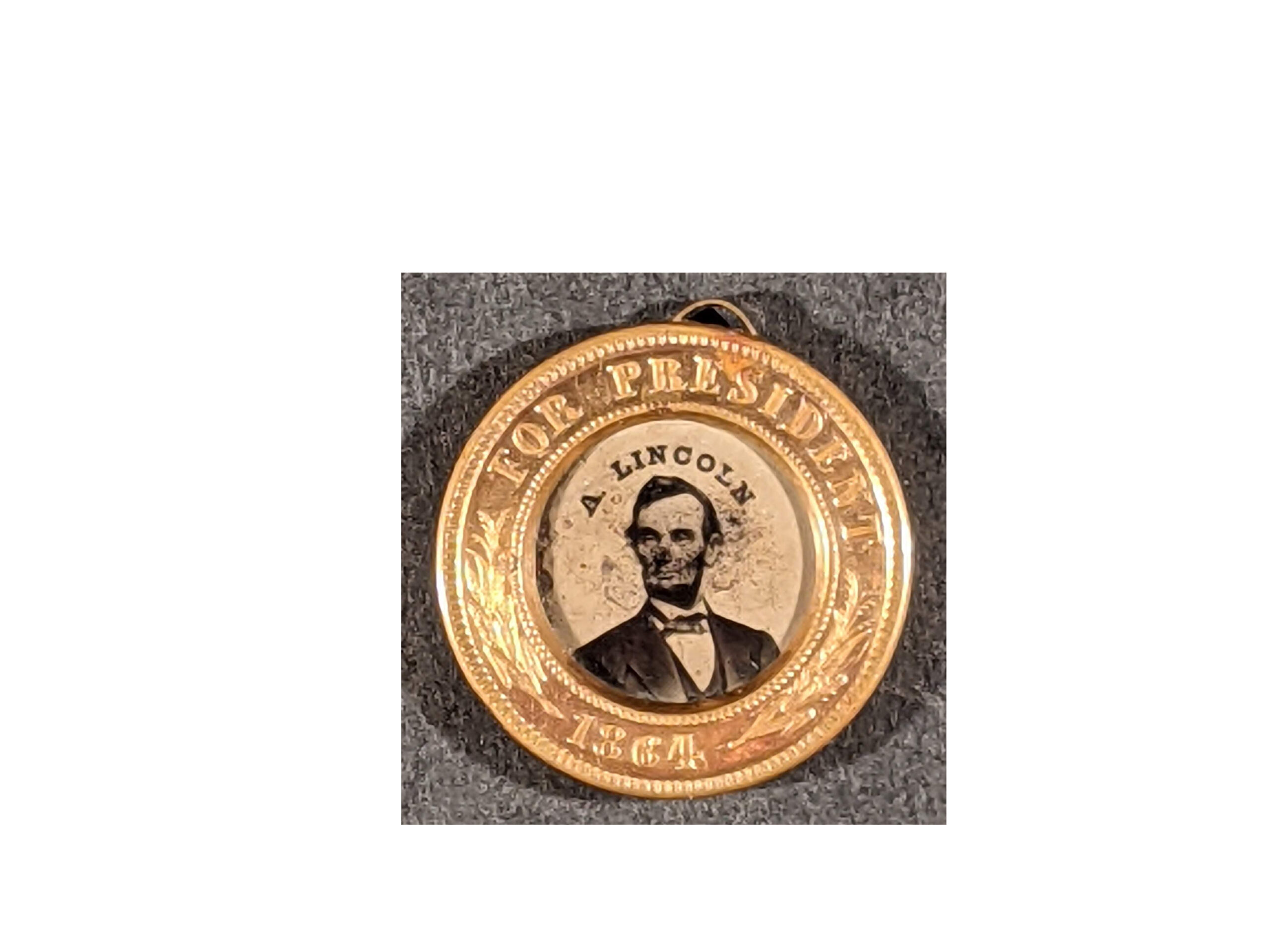
Abraham Lincoln / Andrew Johnson ferrotype button, Lincoln face (recto), 1864
Creator unknown
Abraham Lincoln / Andrew Johnson ferrotype button, Lincoln face (recto), 1864
Facsimile, original in exhibition
Collection of Jerome O. Herlihy
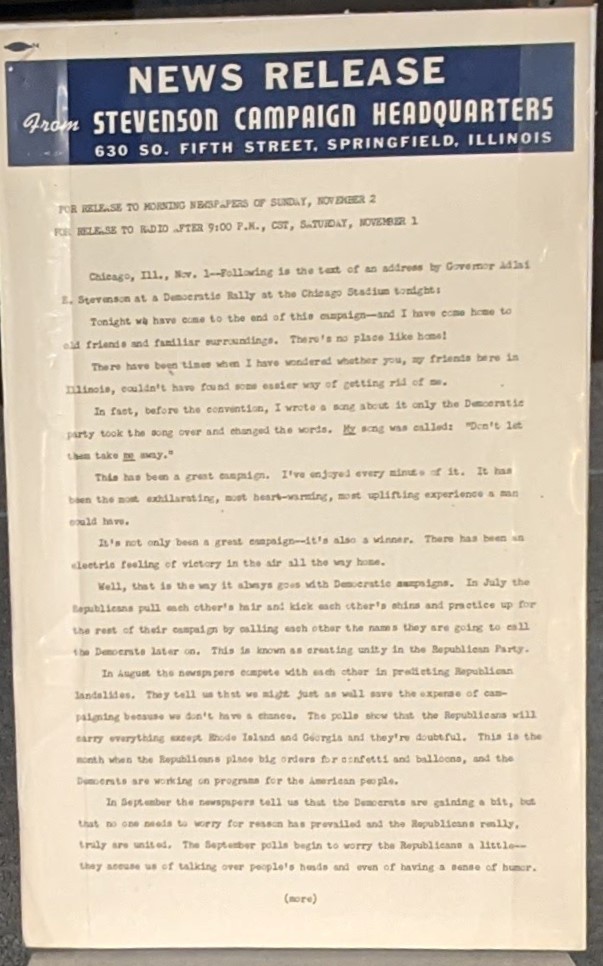
Campaign speech, November 1, 1952
Adlai Stevenson
Campaign speech, November 1, 1952
Adlai Stevenson 1952 presidential campaign speeches

A century of campaign buttons, 1789-1889; a descriptive list of medalets, tokens, buttons, ferrotypes, and other lapel devices relating to the national political campaigns in the United States from 1789 to 1889.
DeWitt, J. Doyle. 1959. A century of campaign buttons, 1789-1889; a descriptive list of medalets, tokens, buttons, ferrotypes, and other lapel devices relating to the national political campaigns in the United States from 1789 to 1889.
More about this item

 Close
Close
